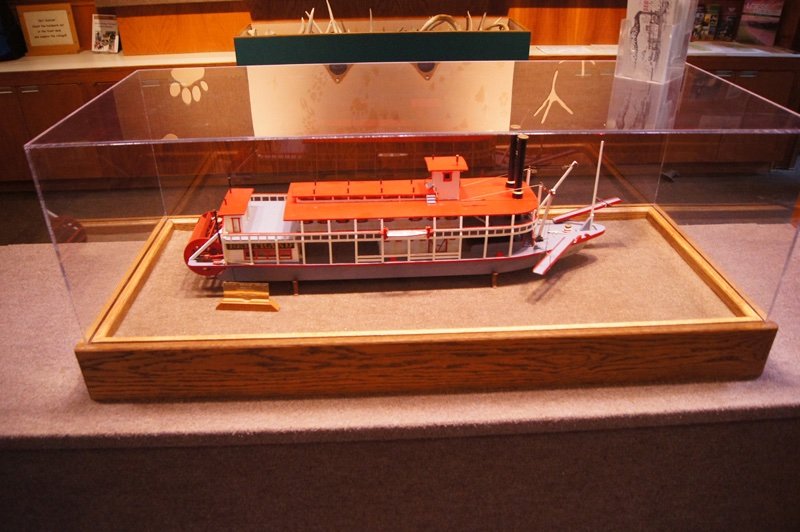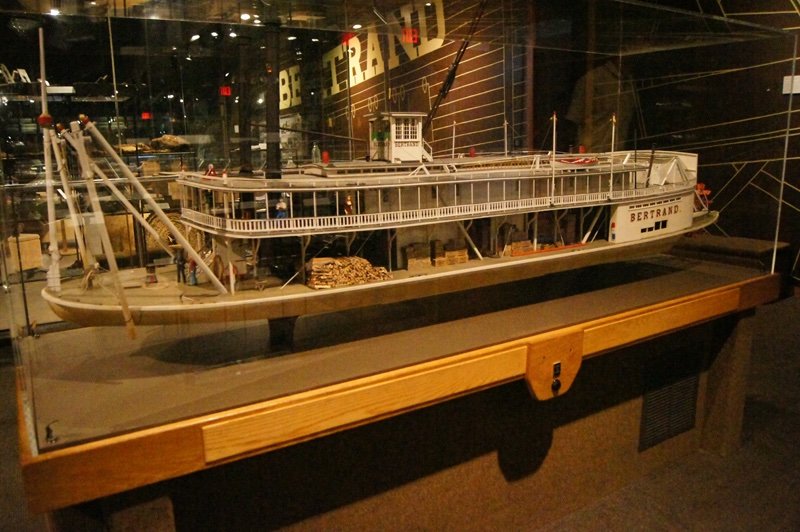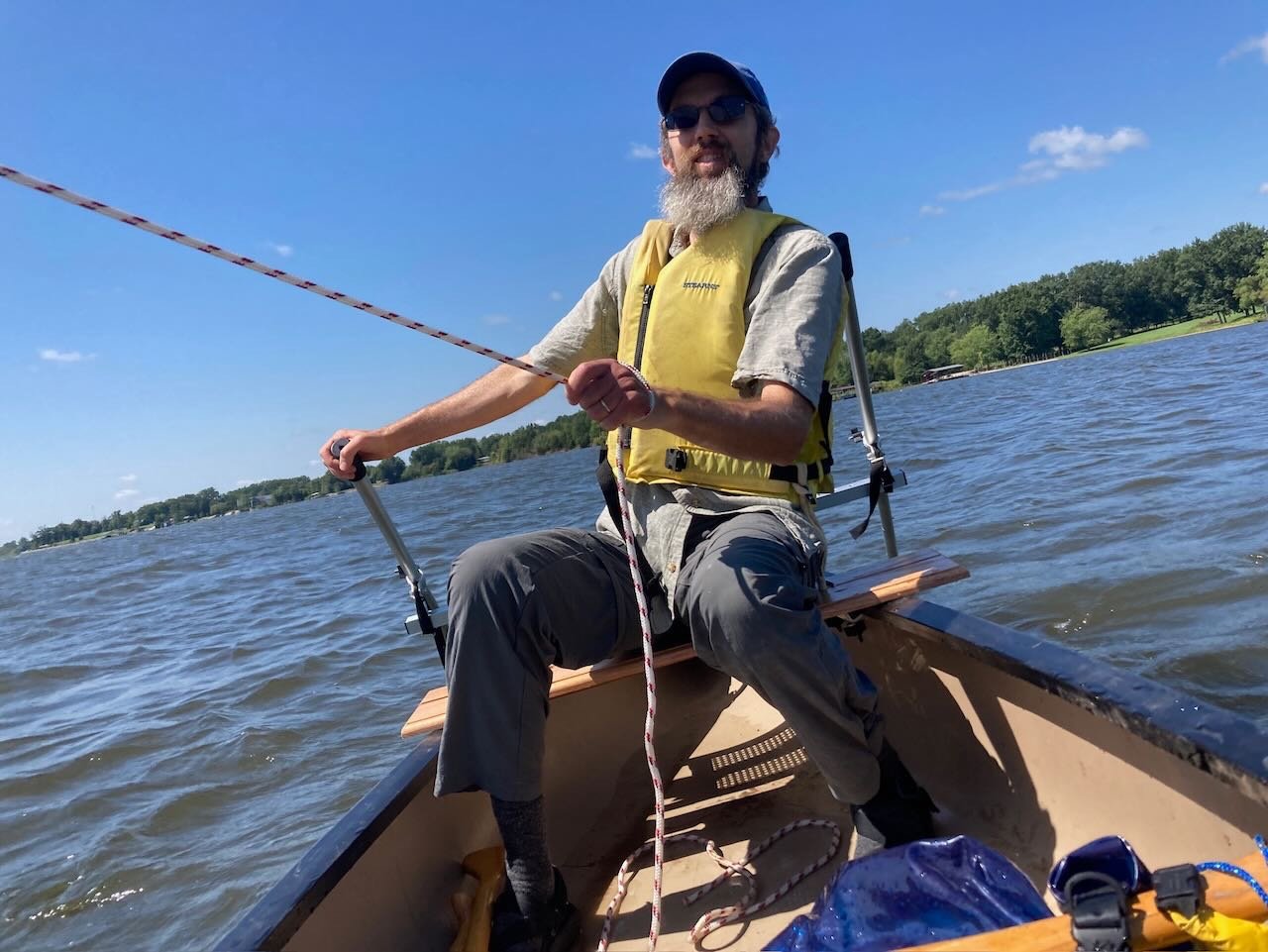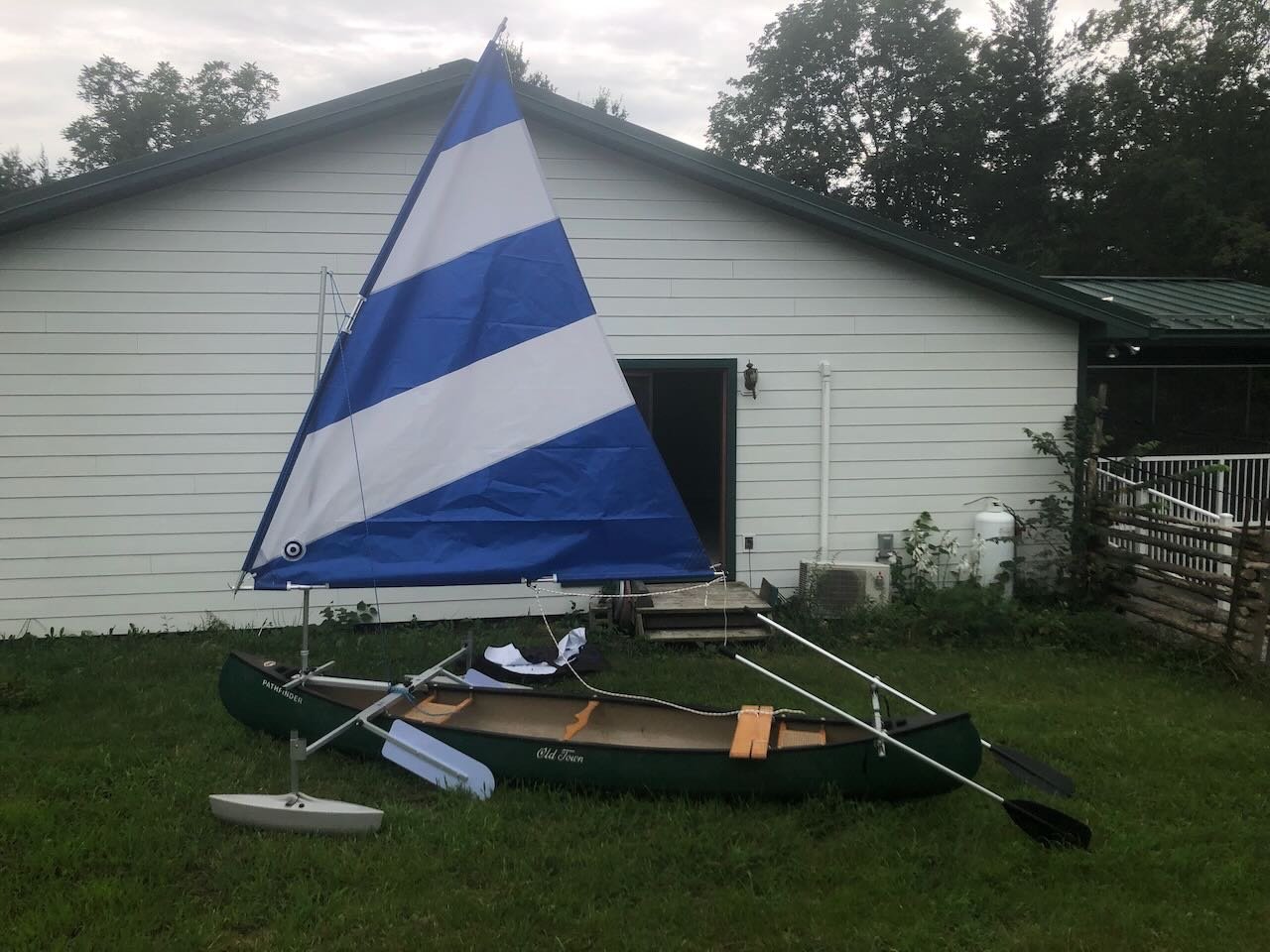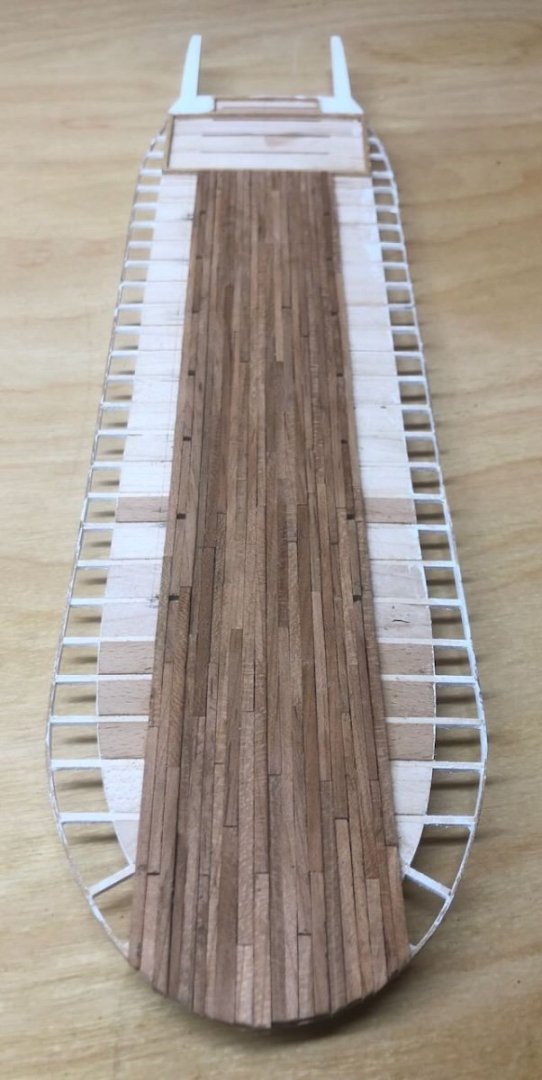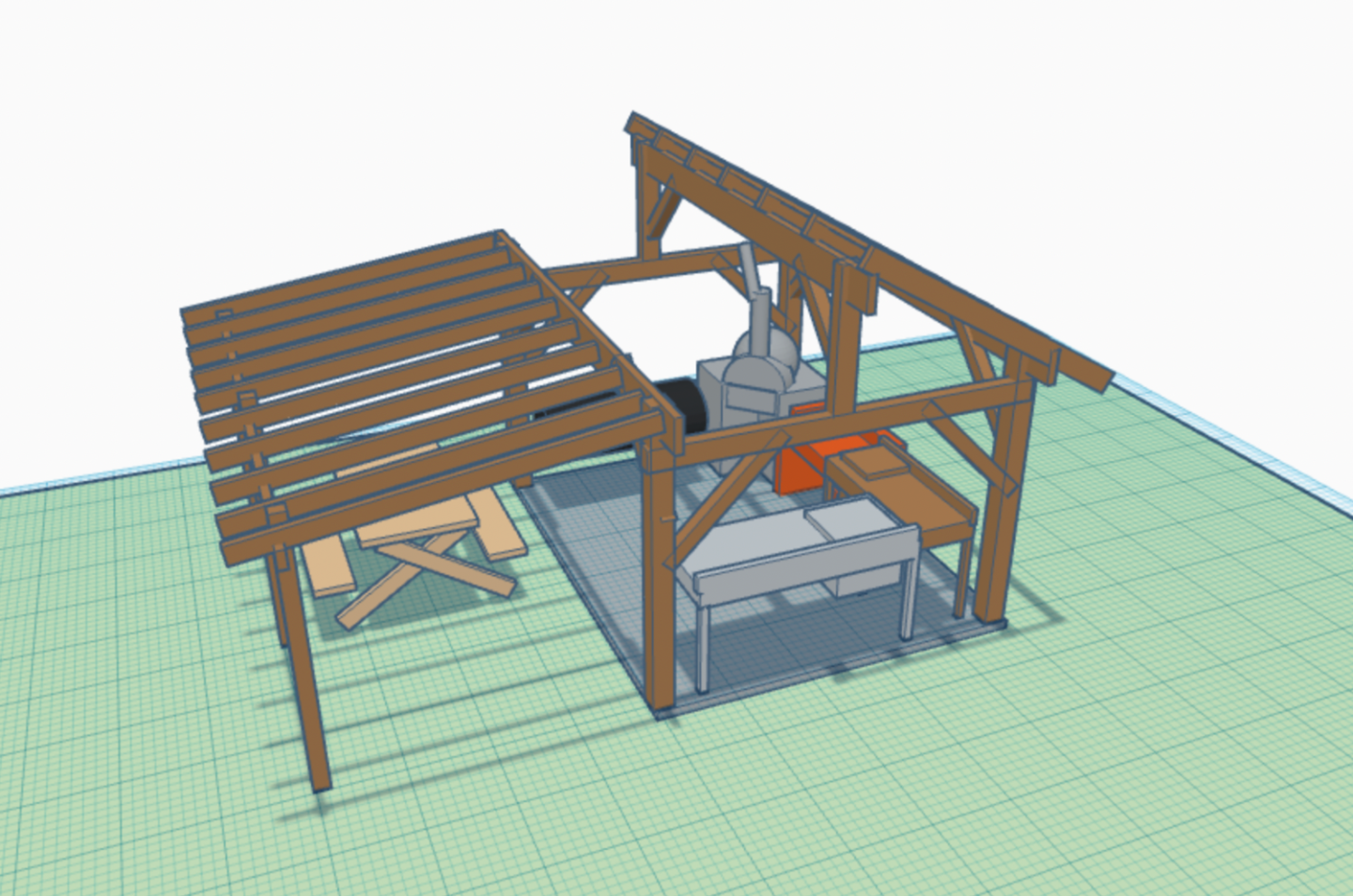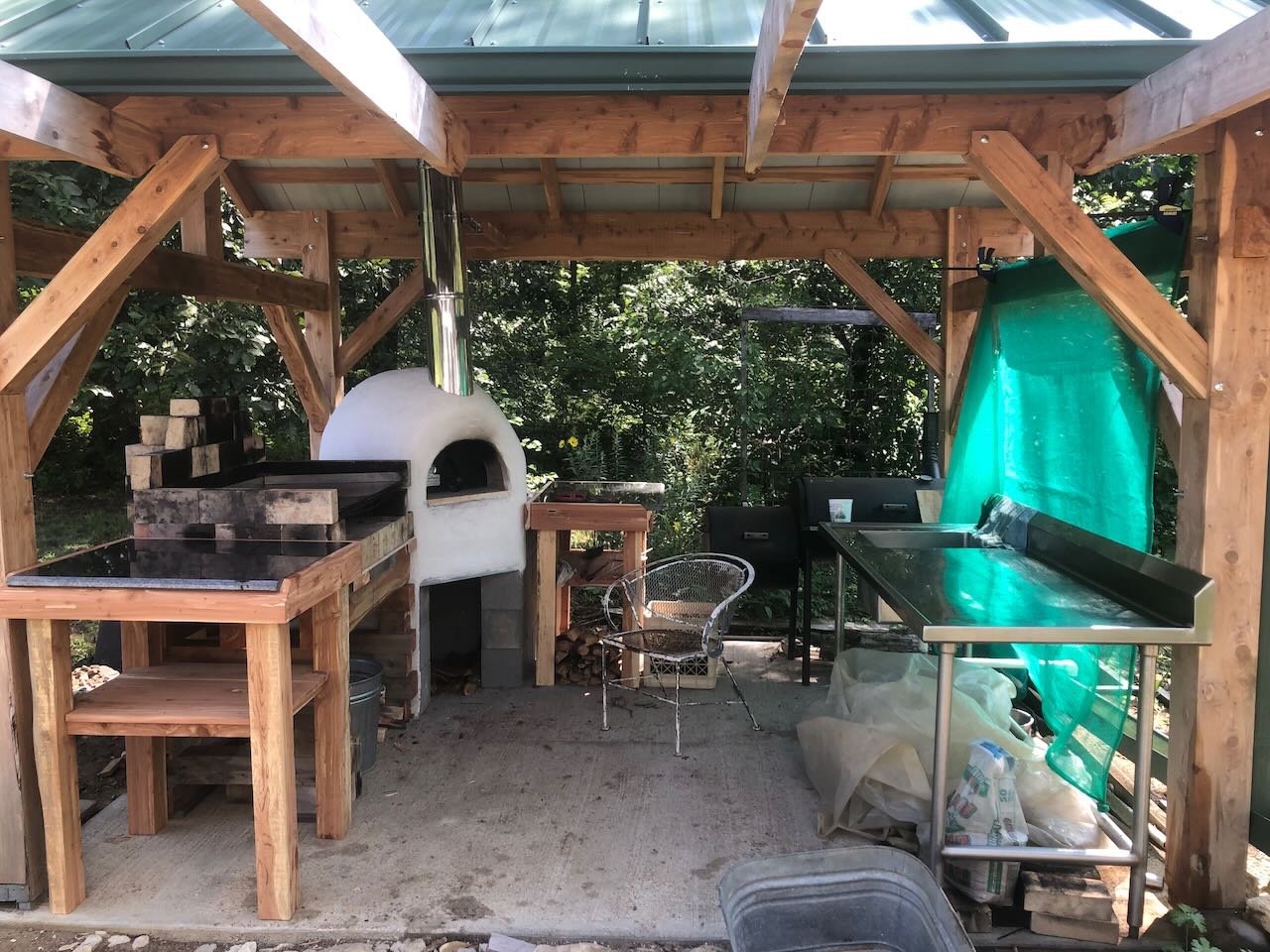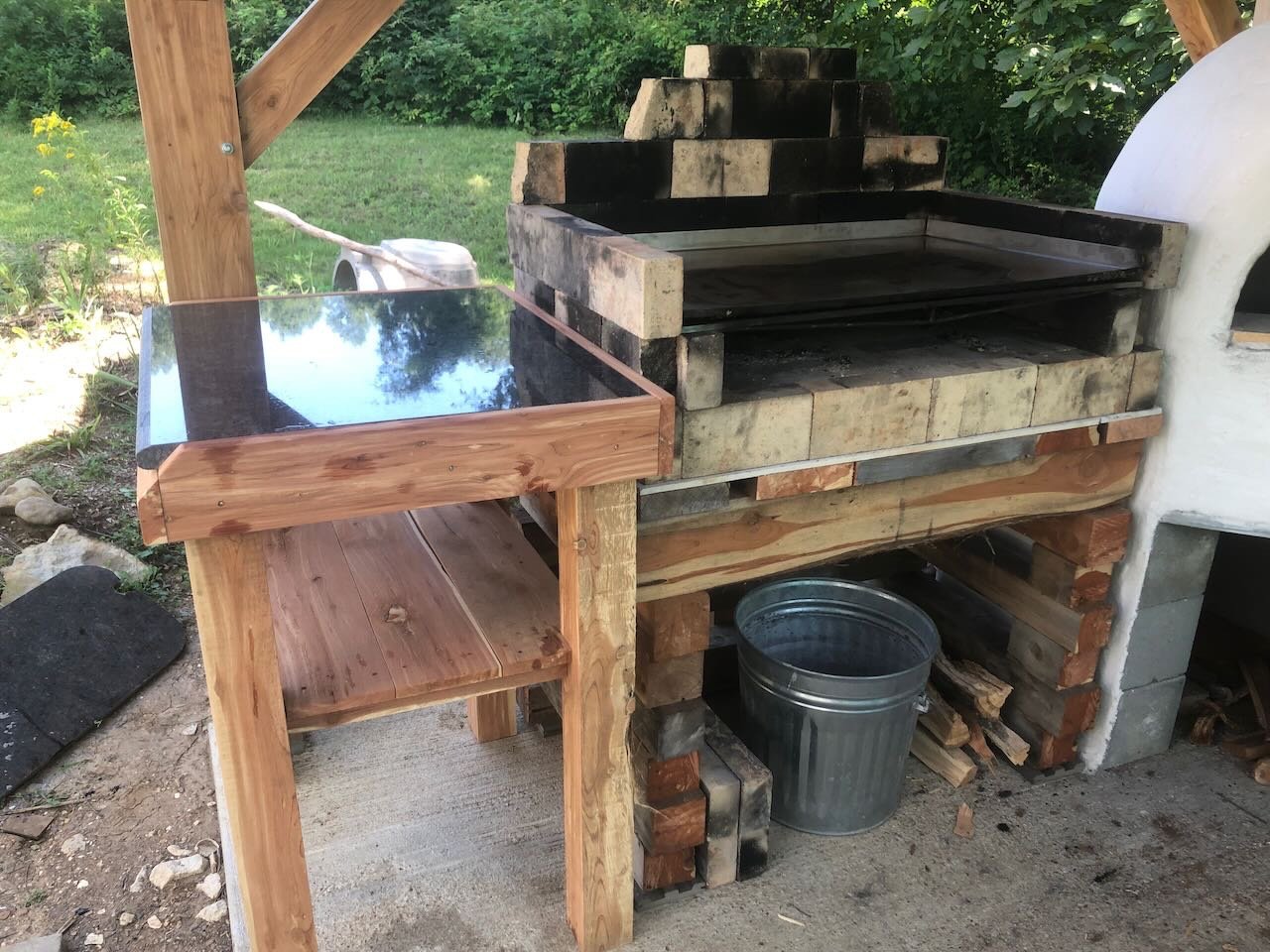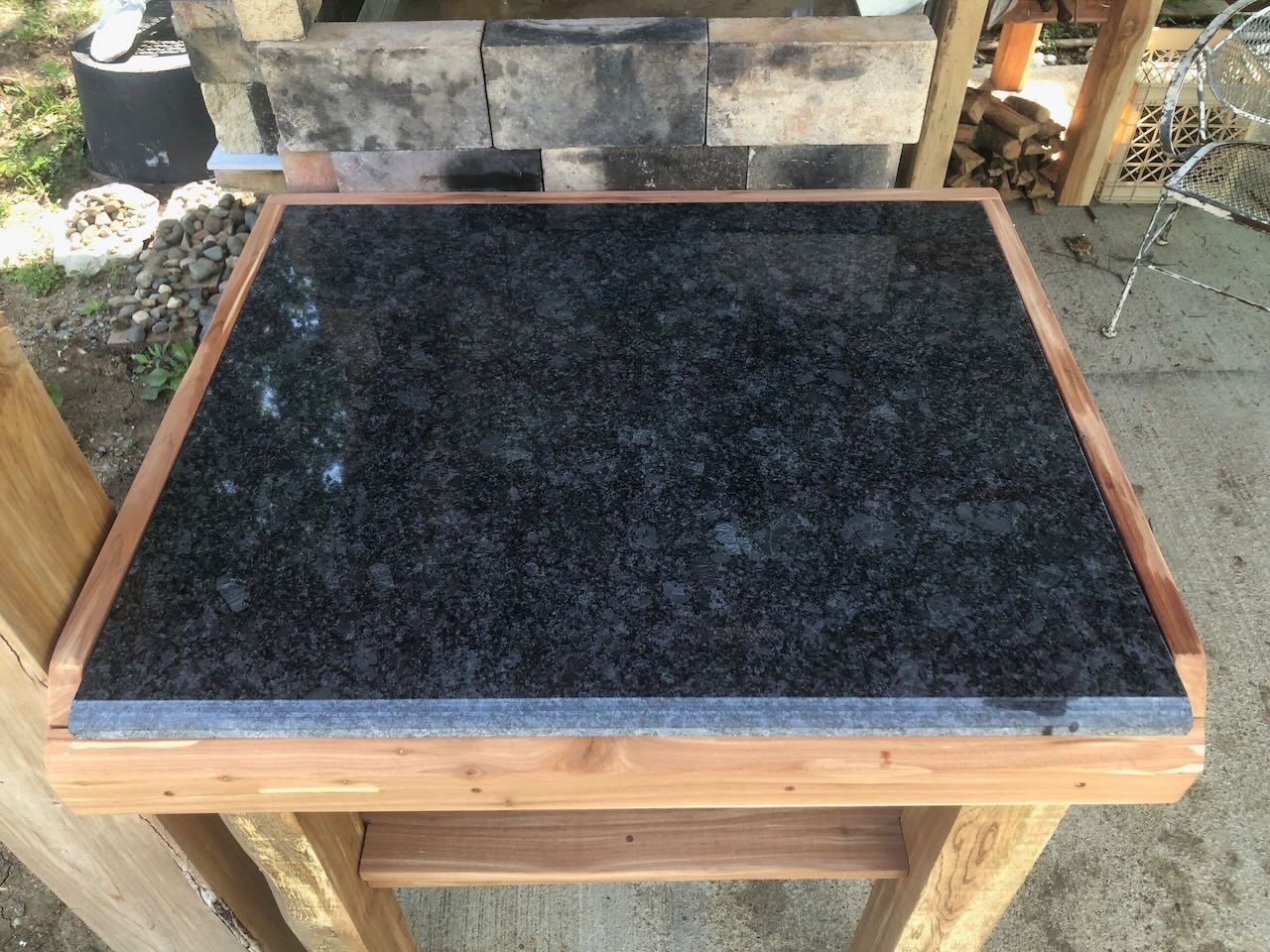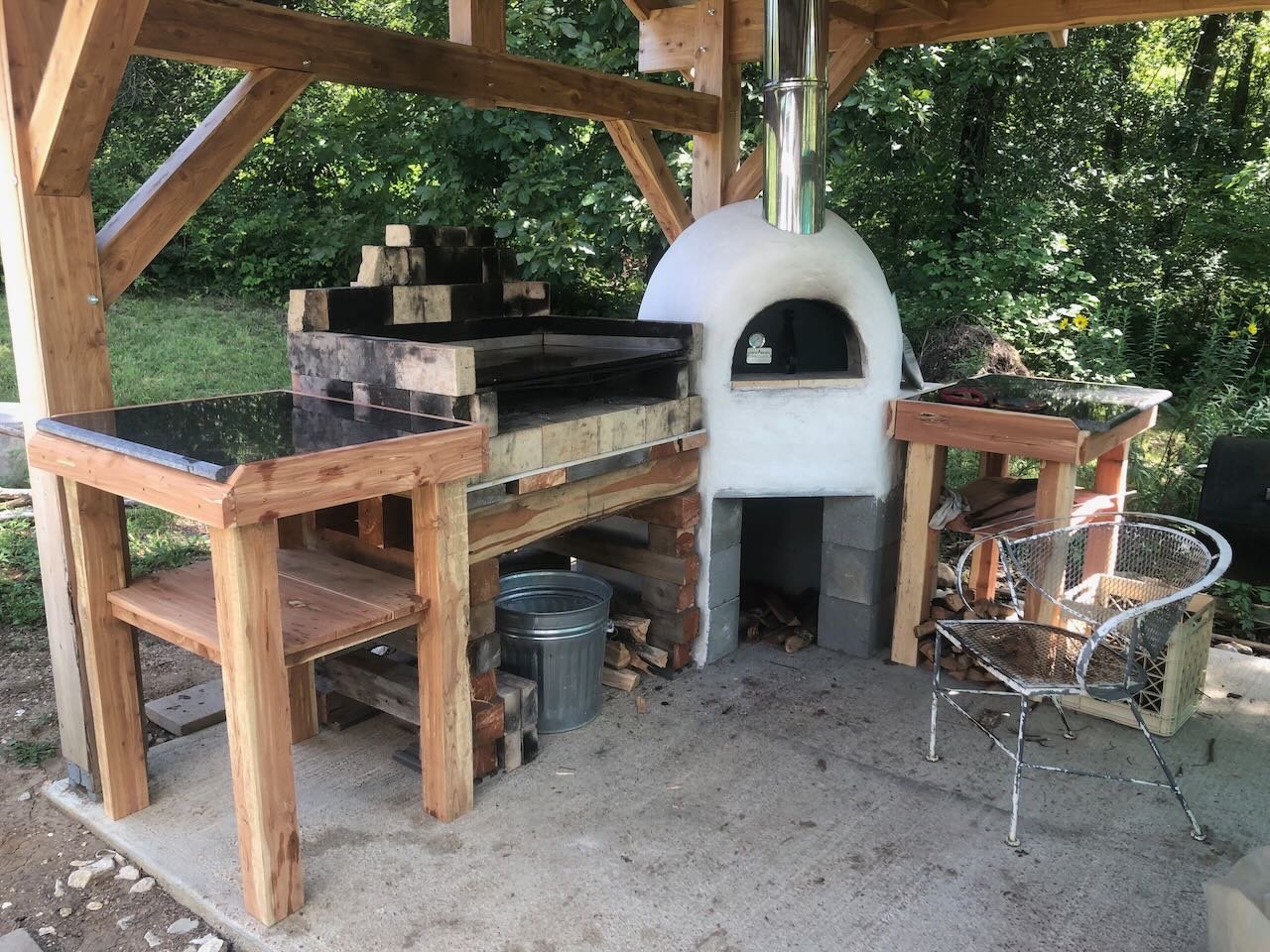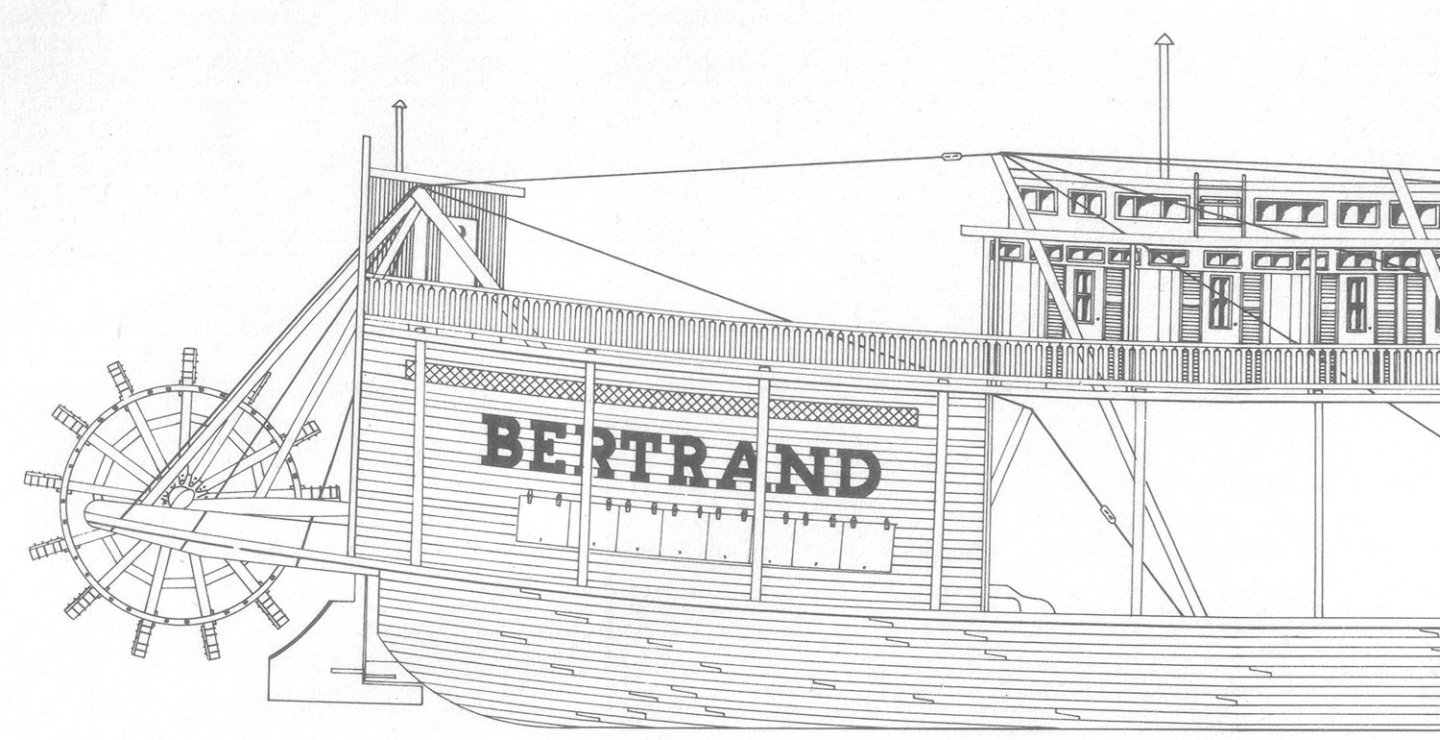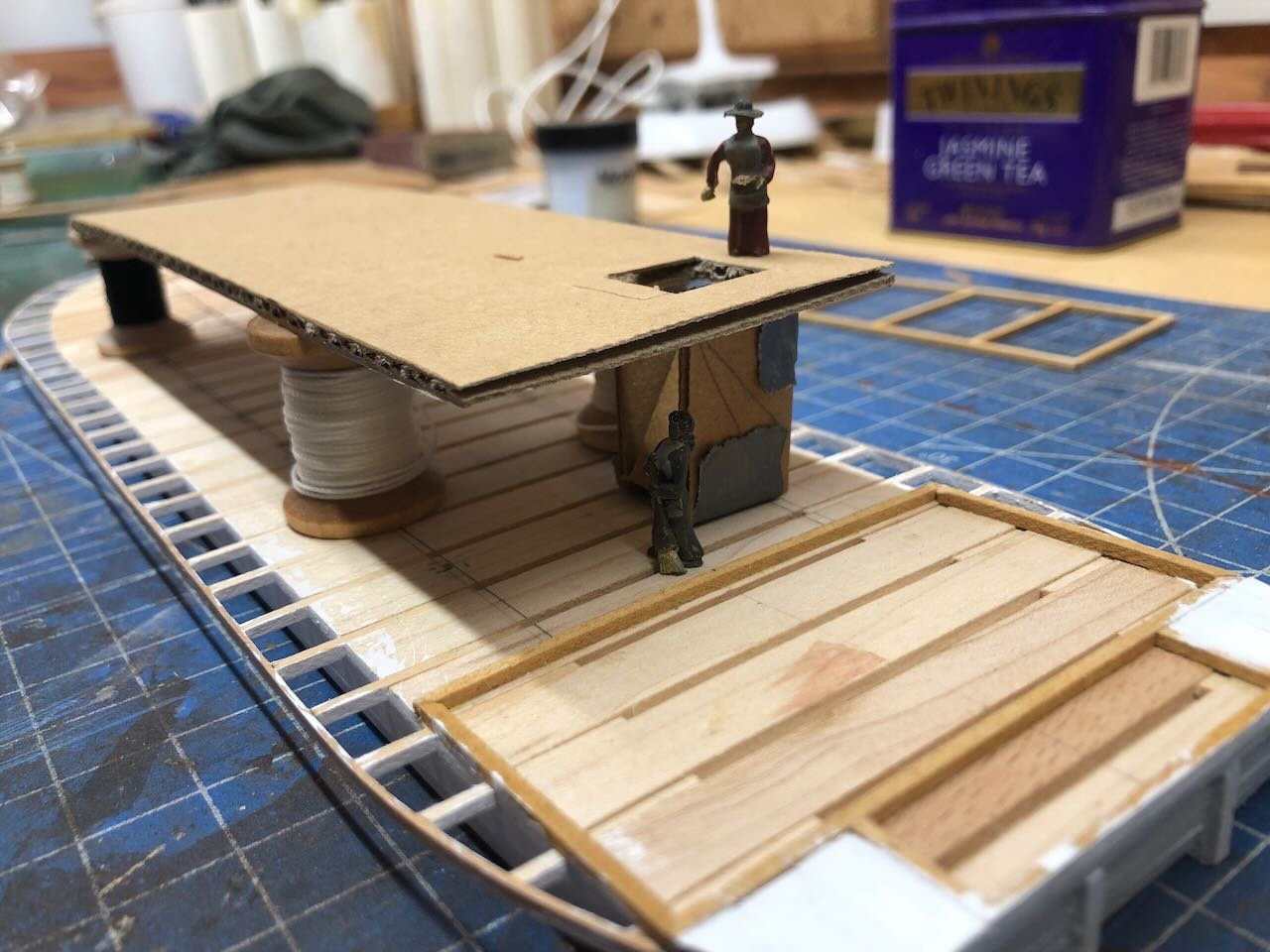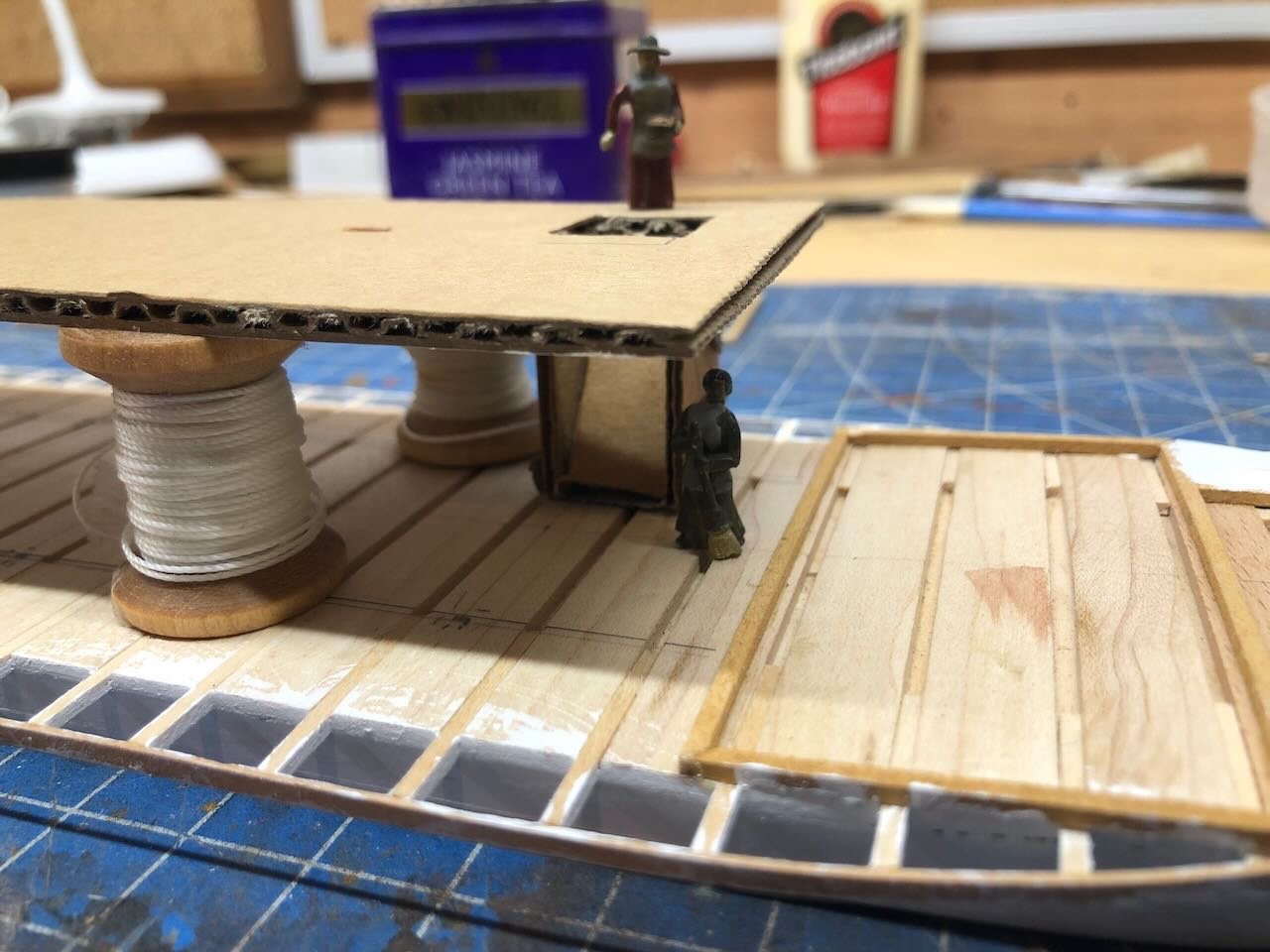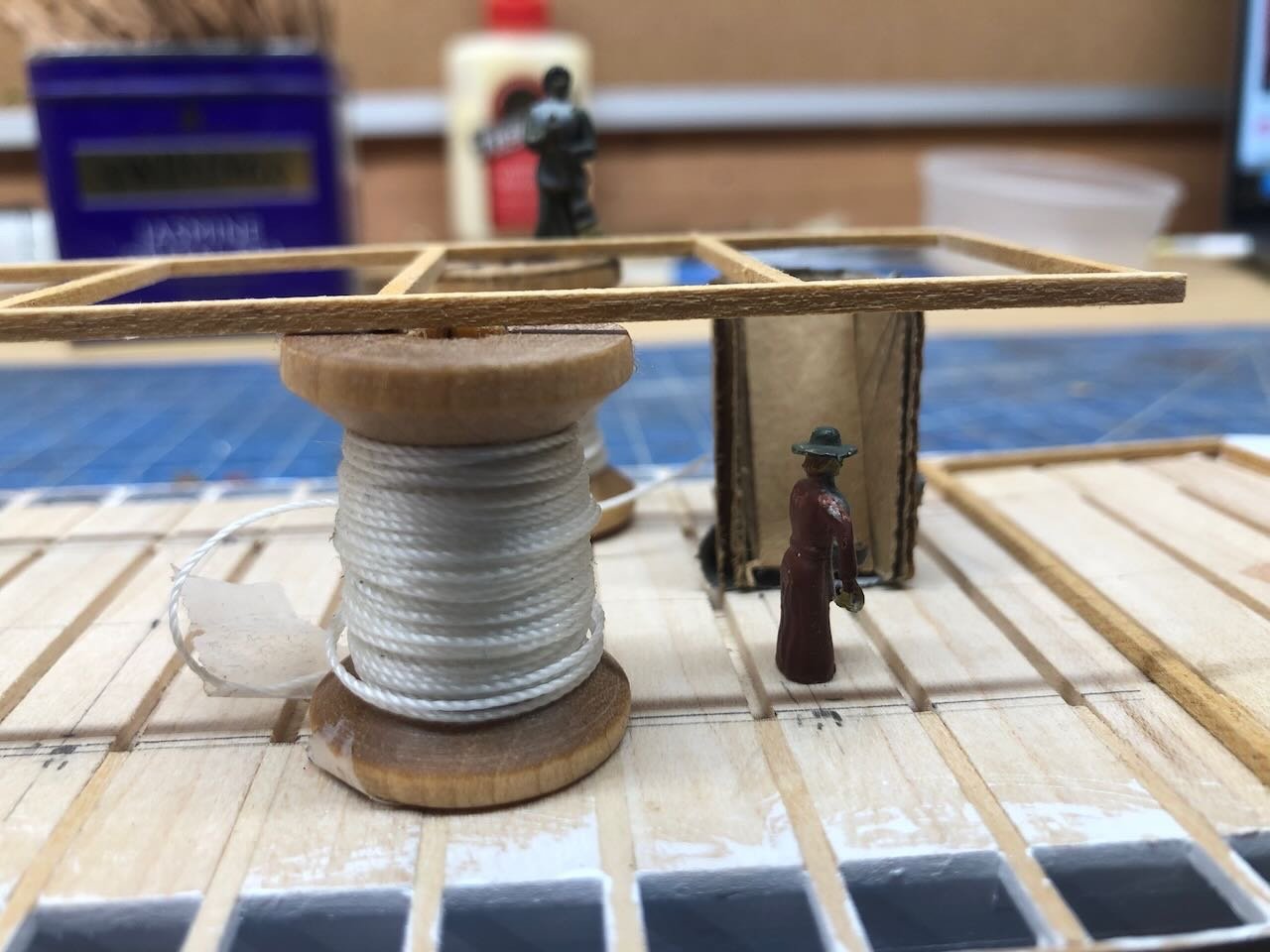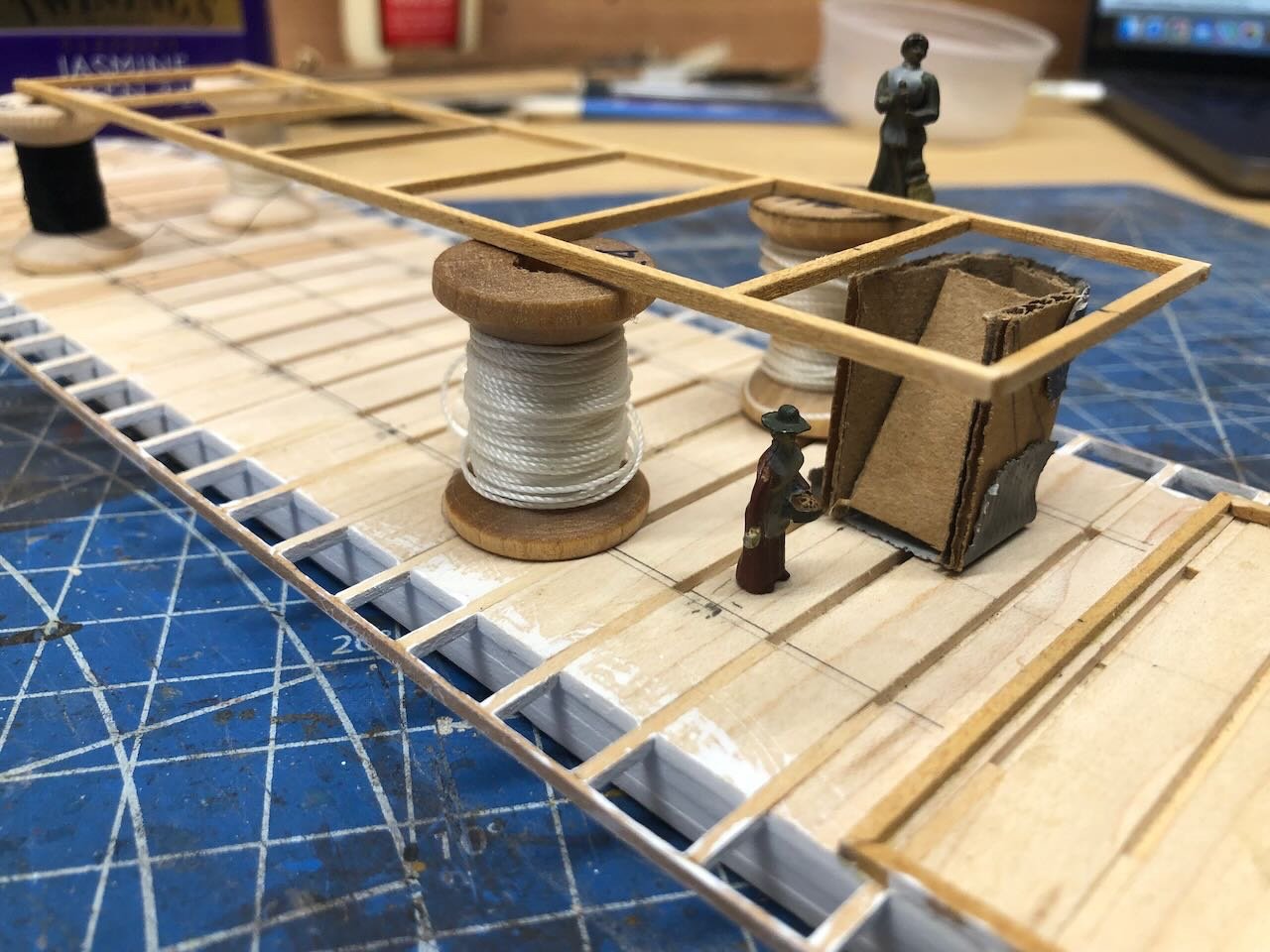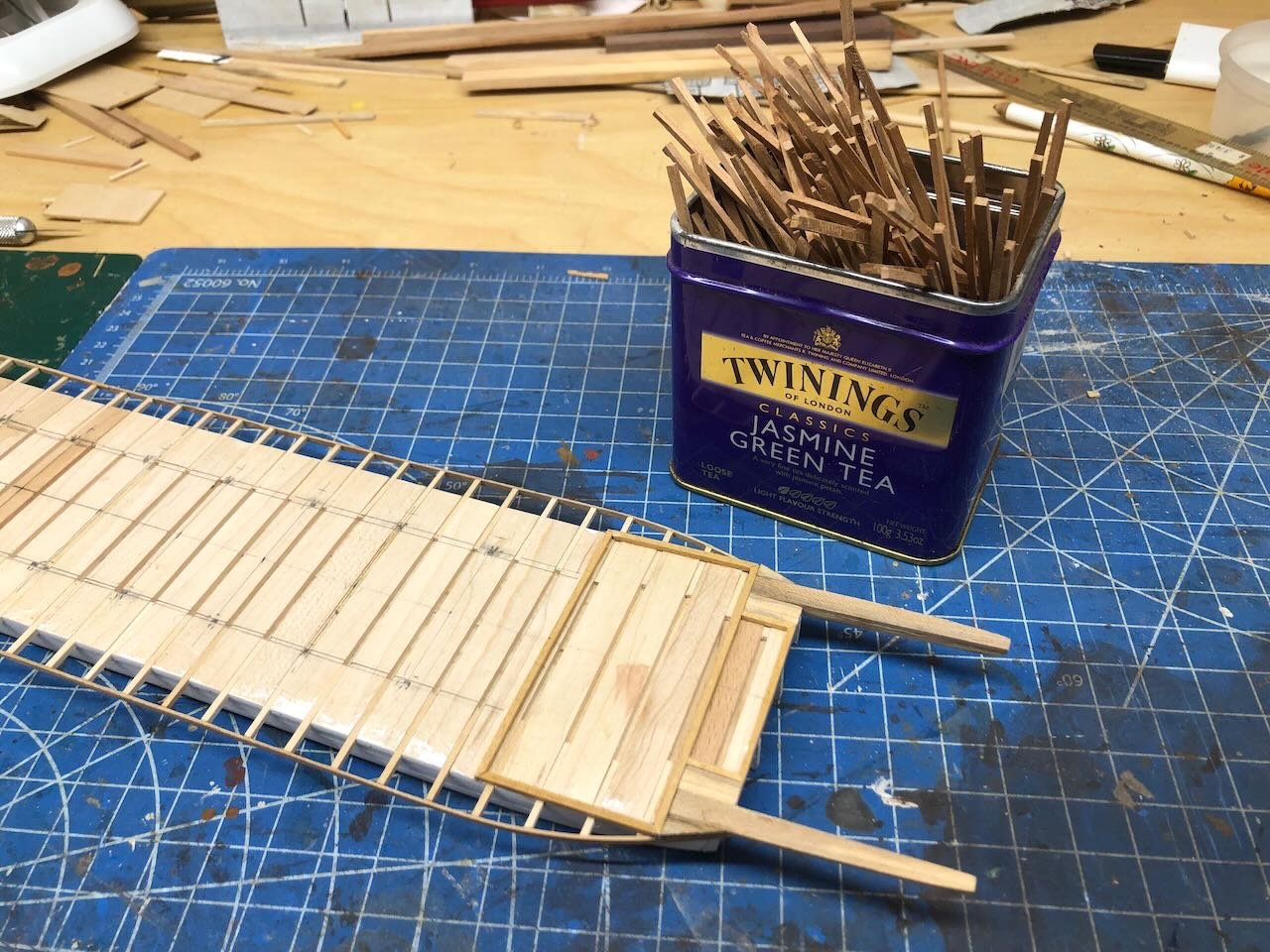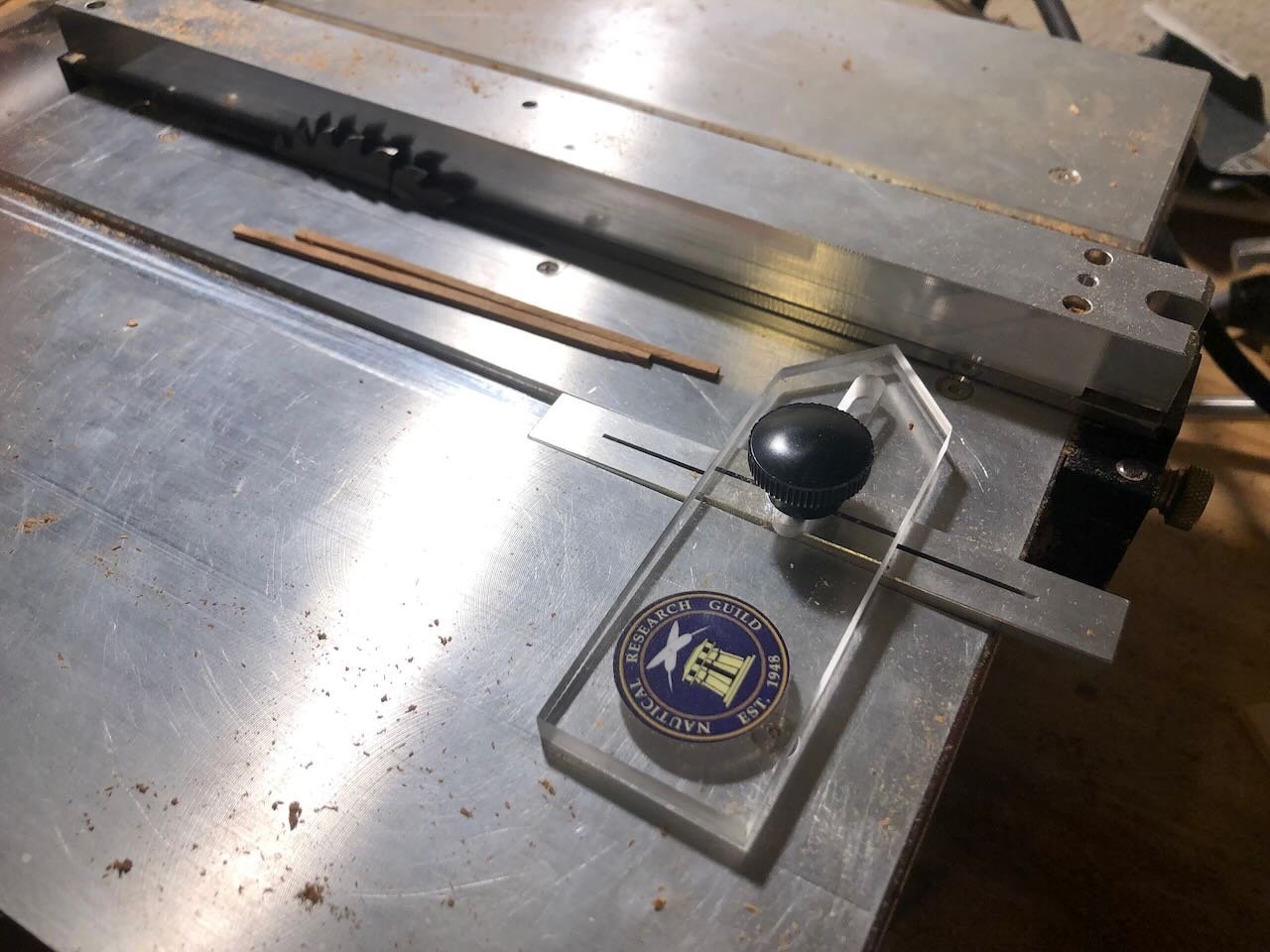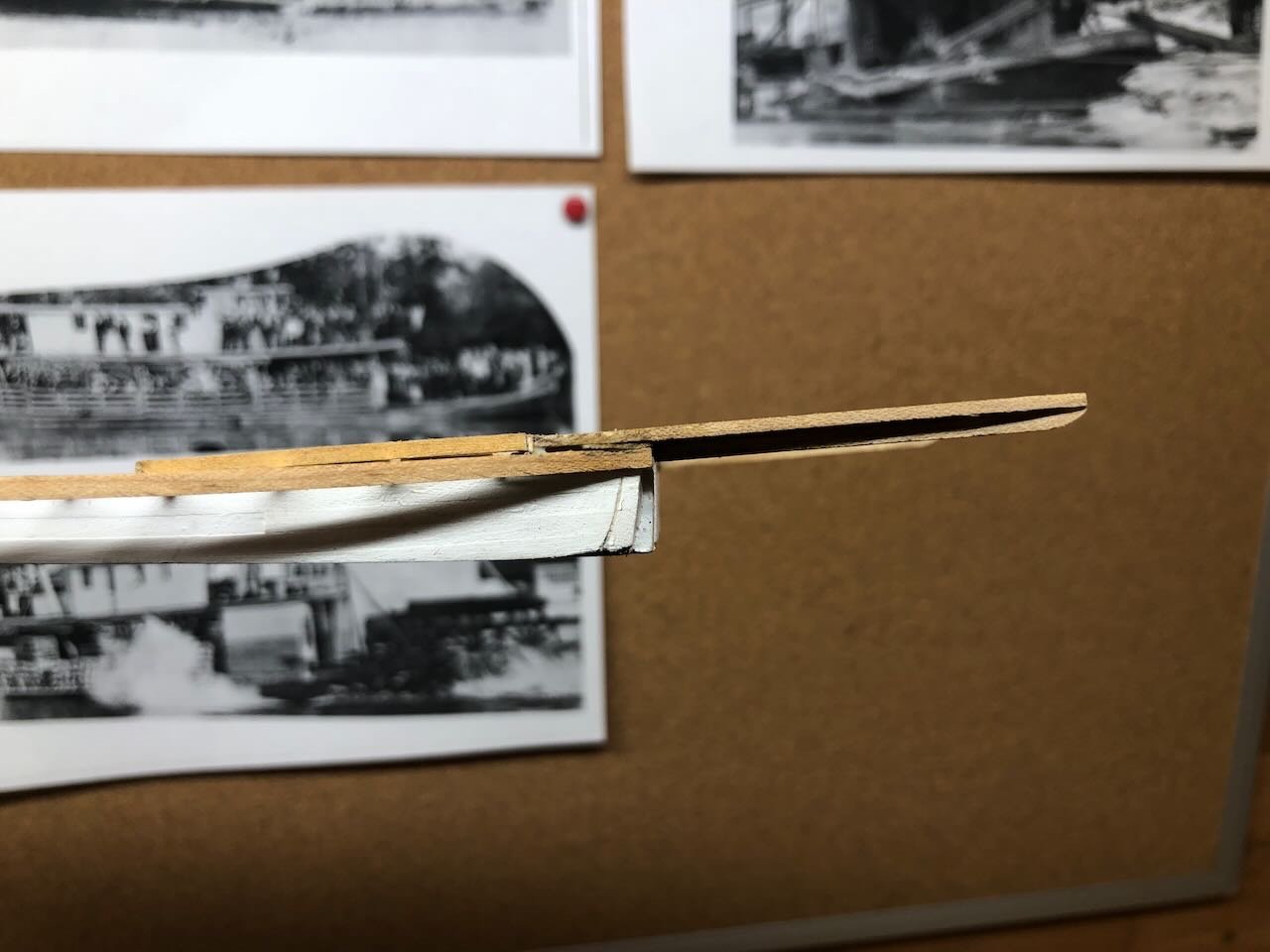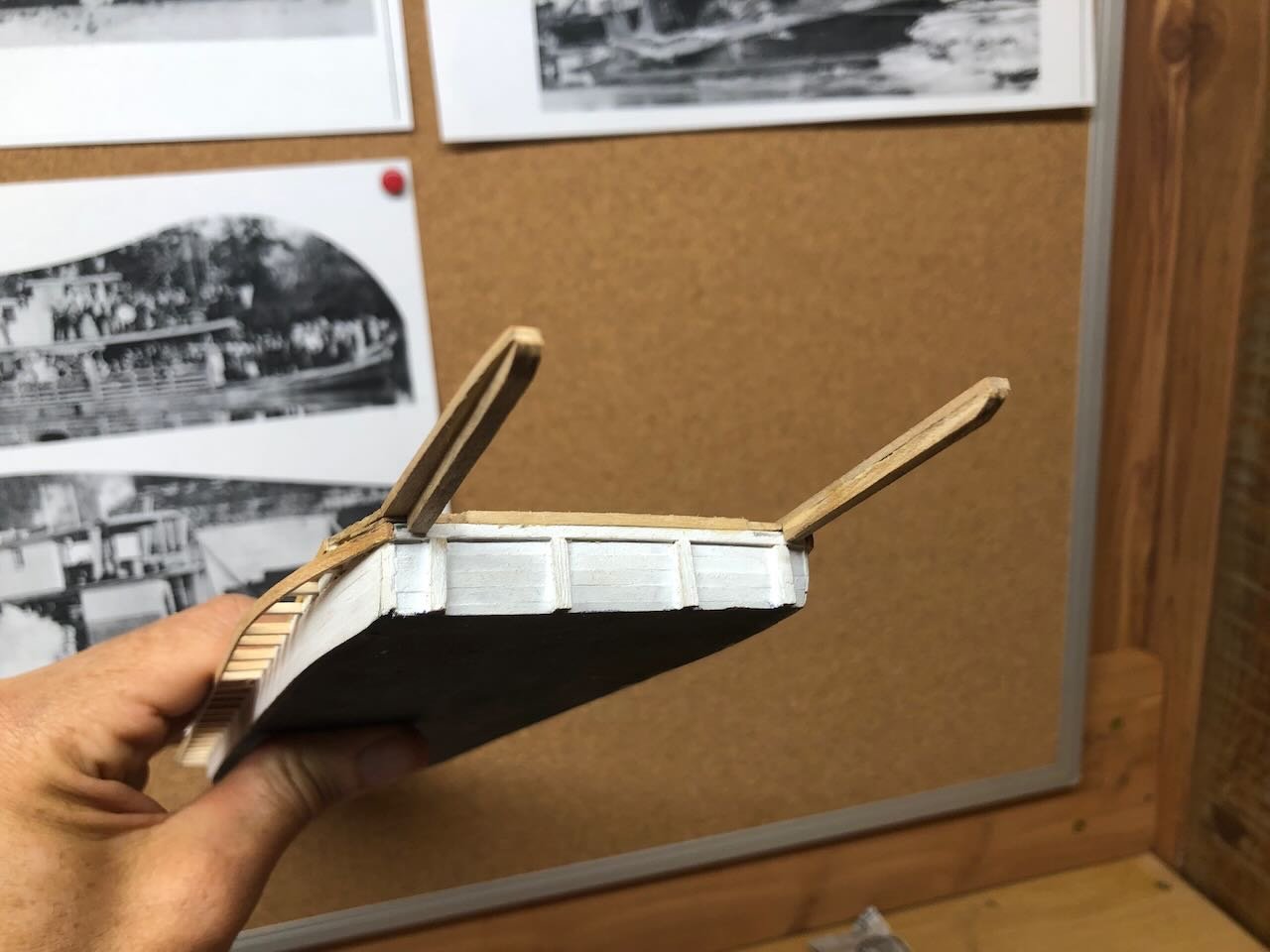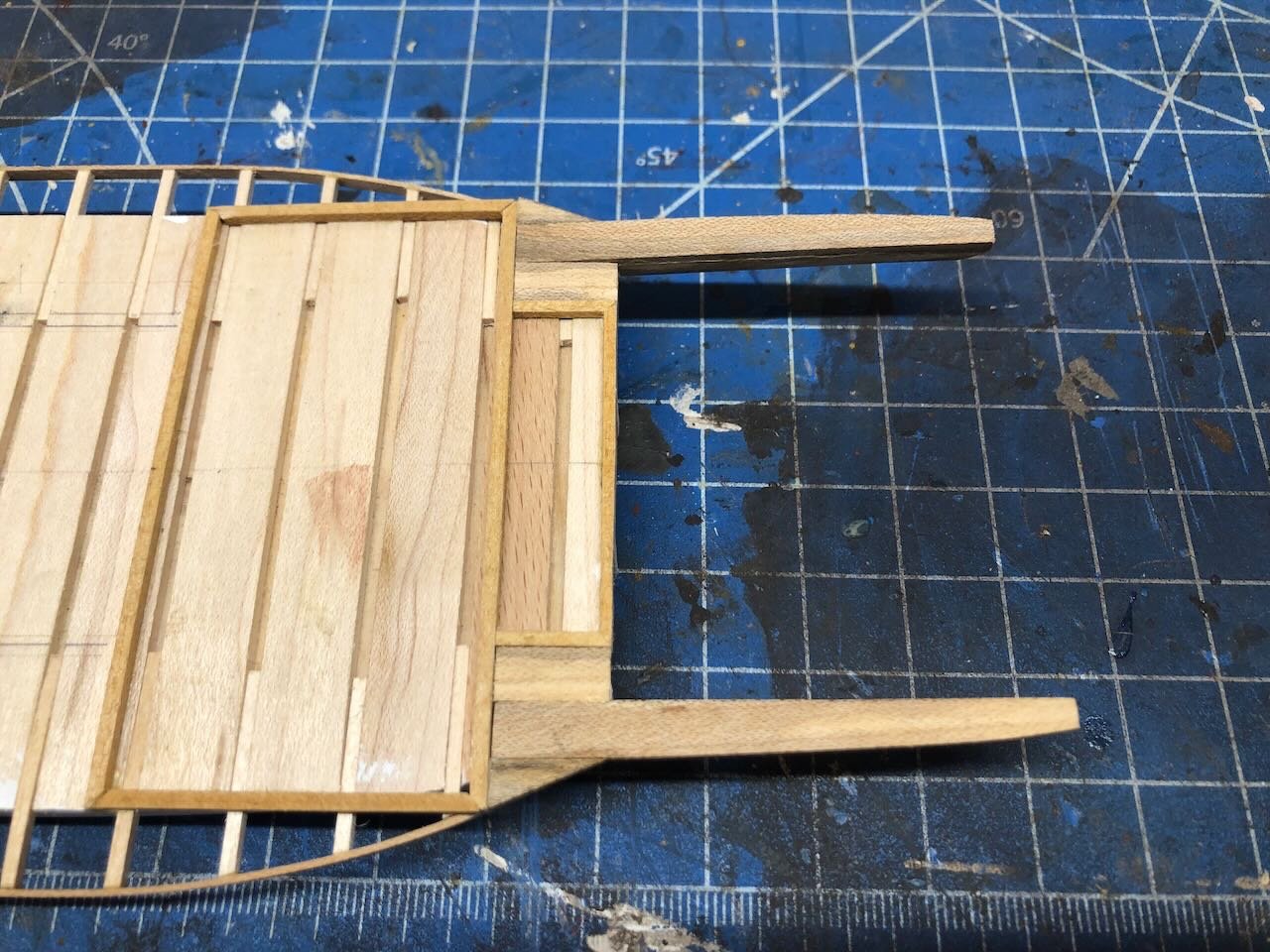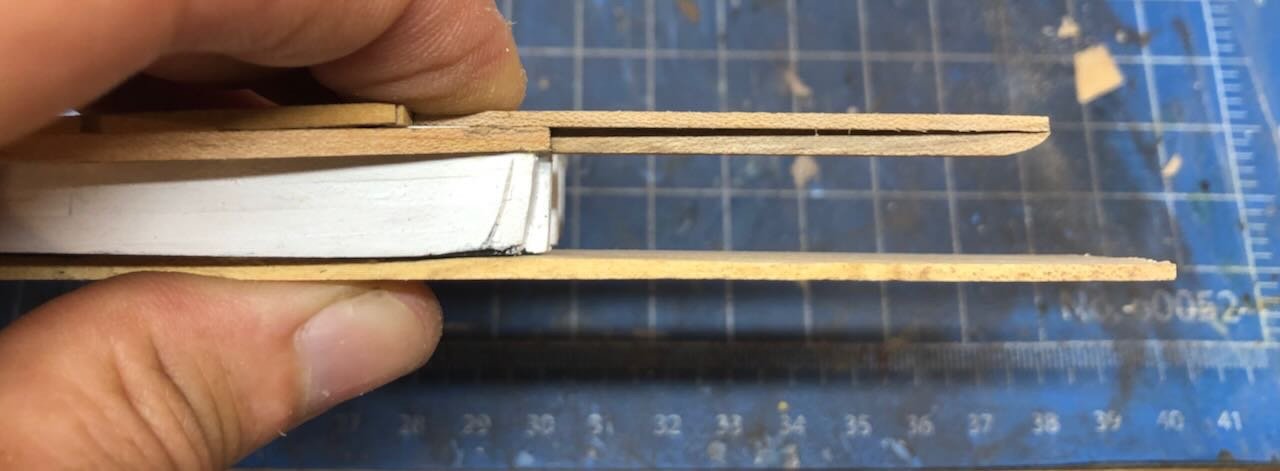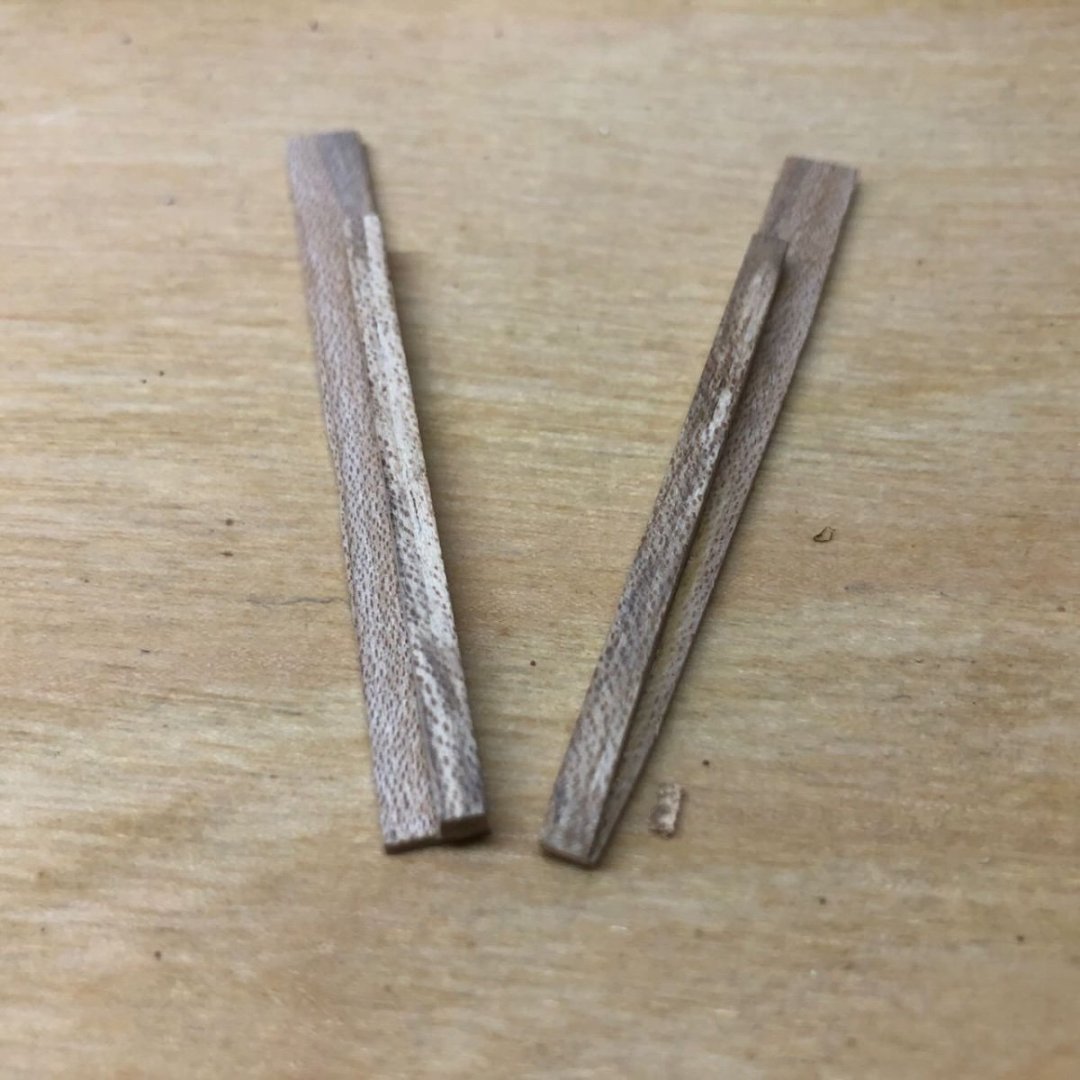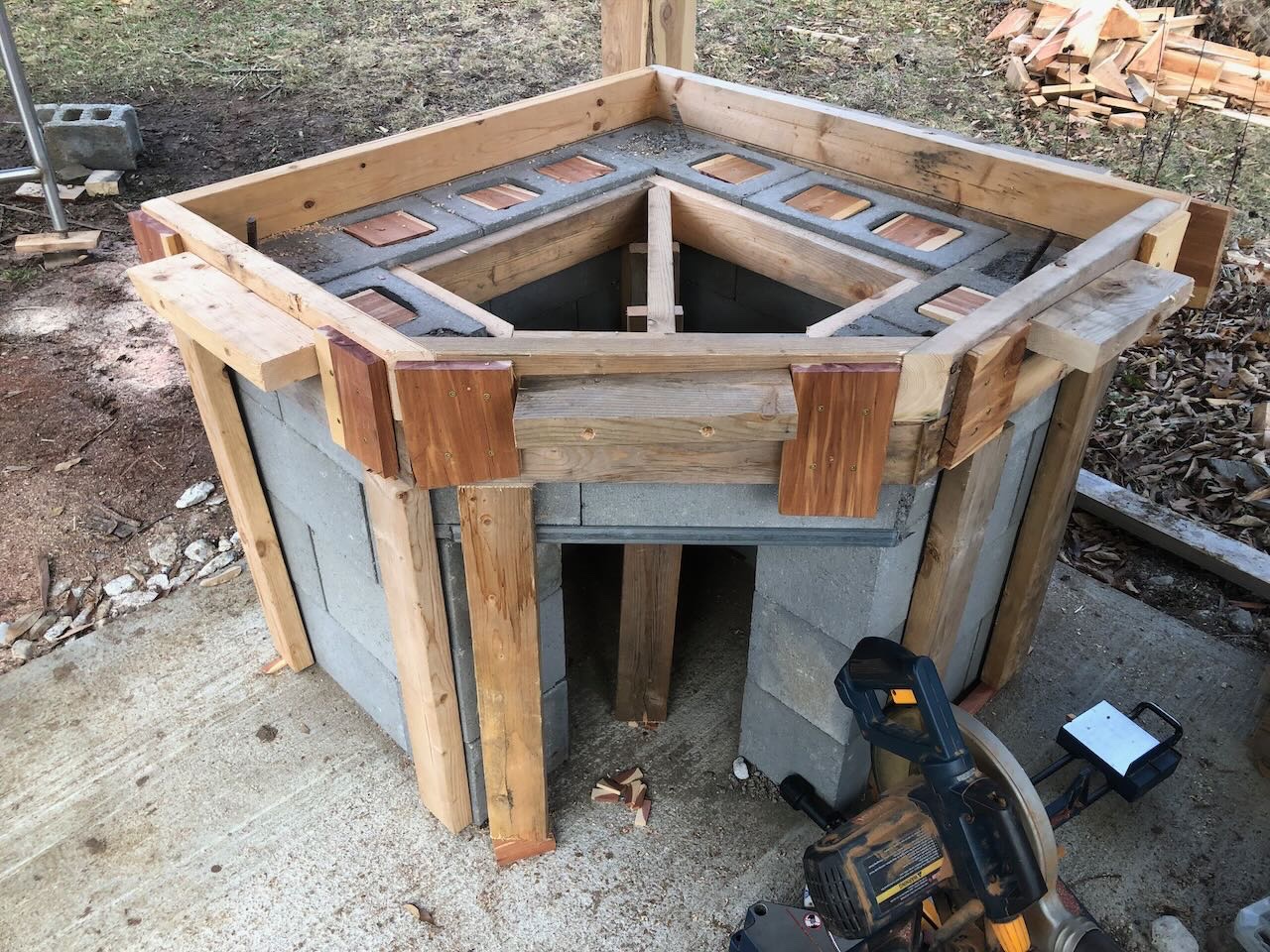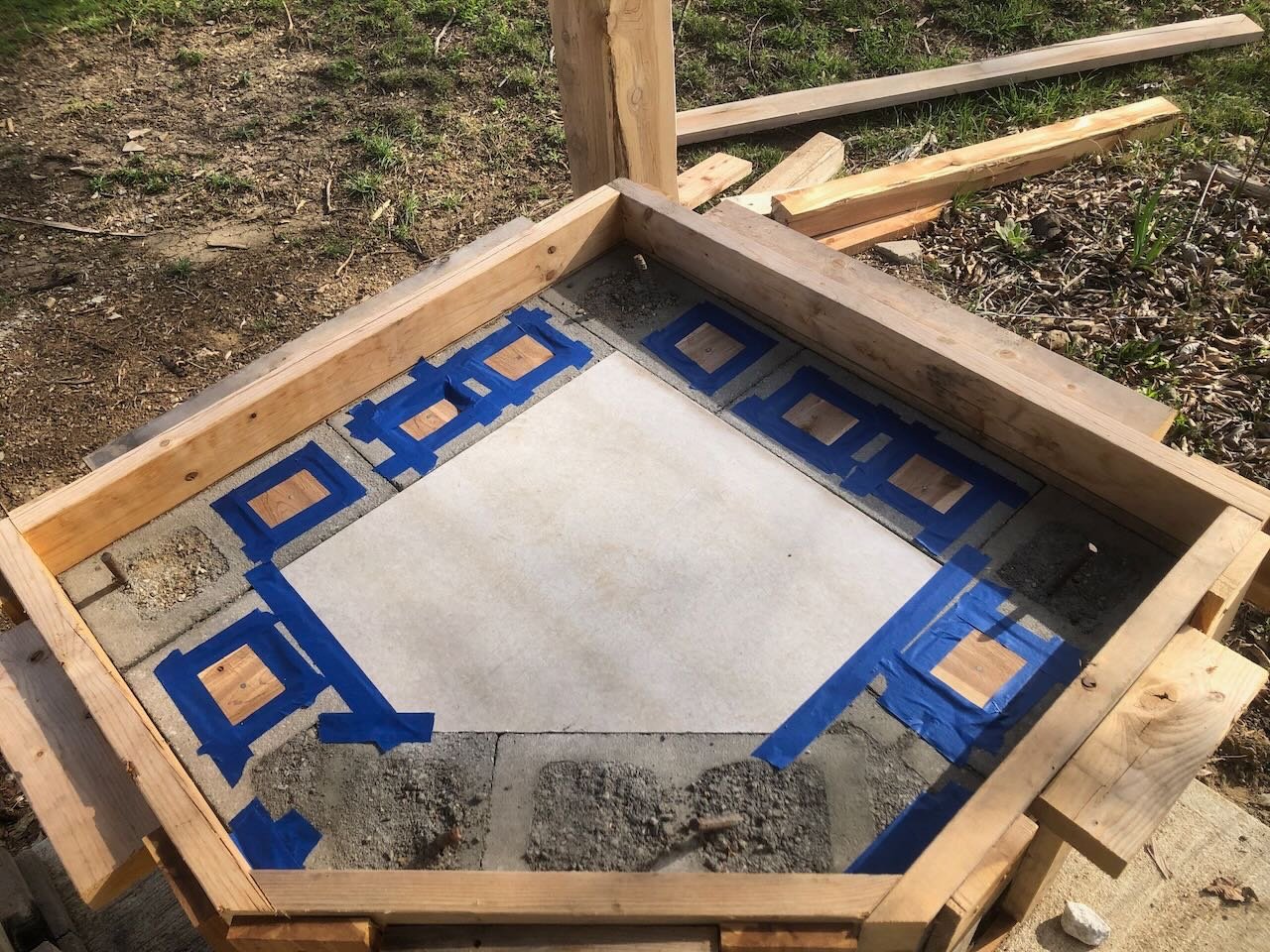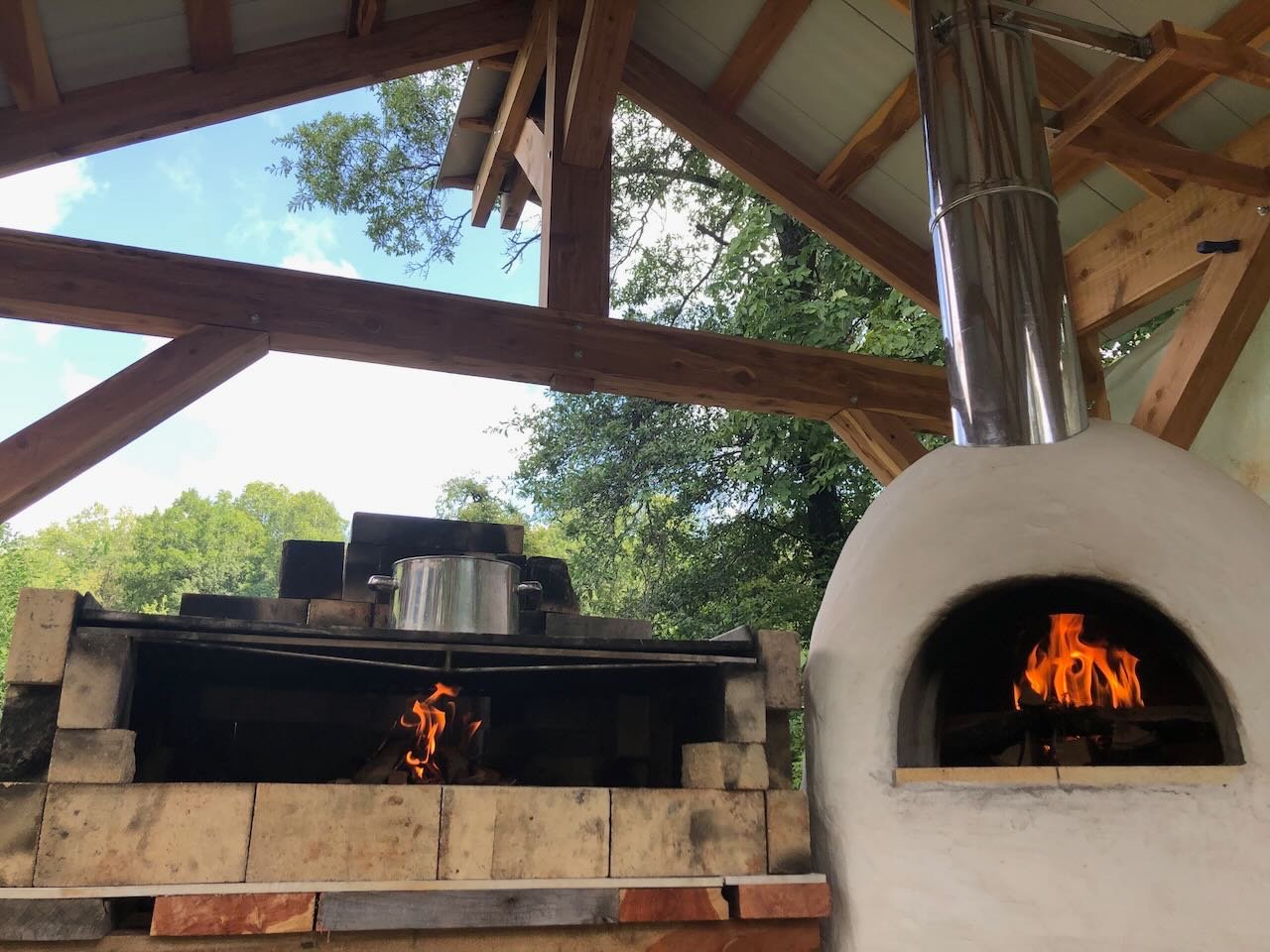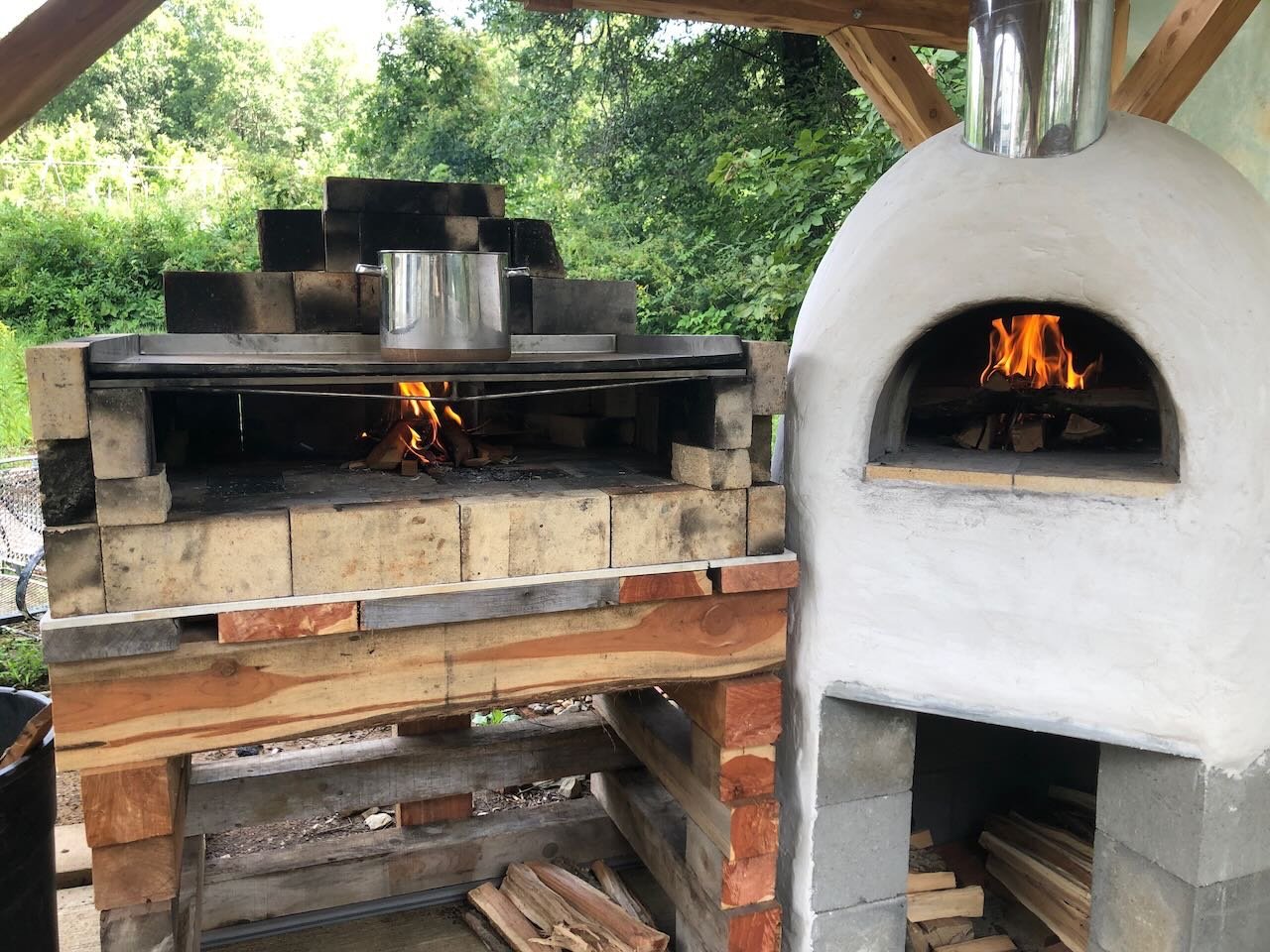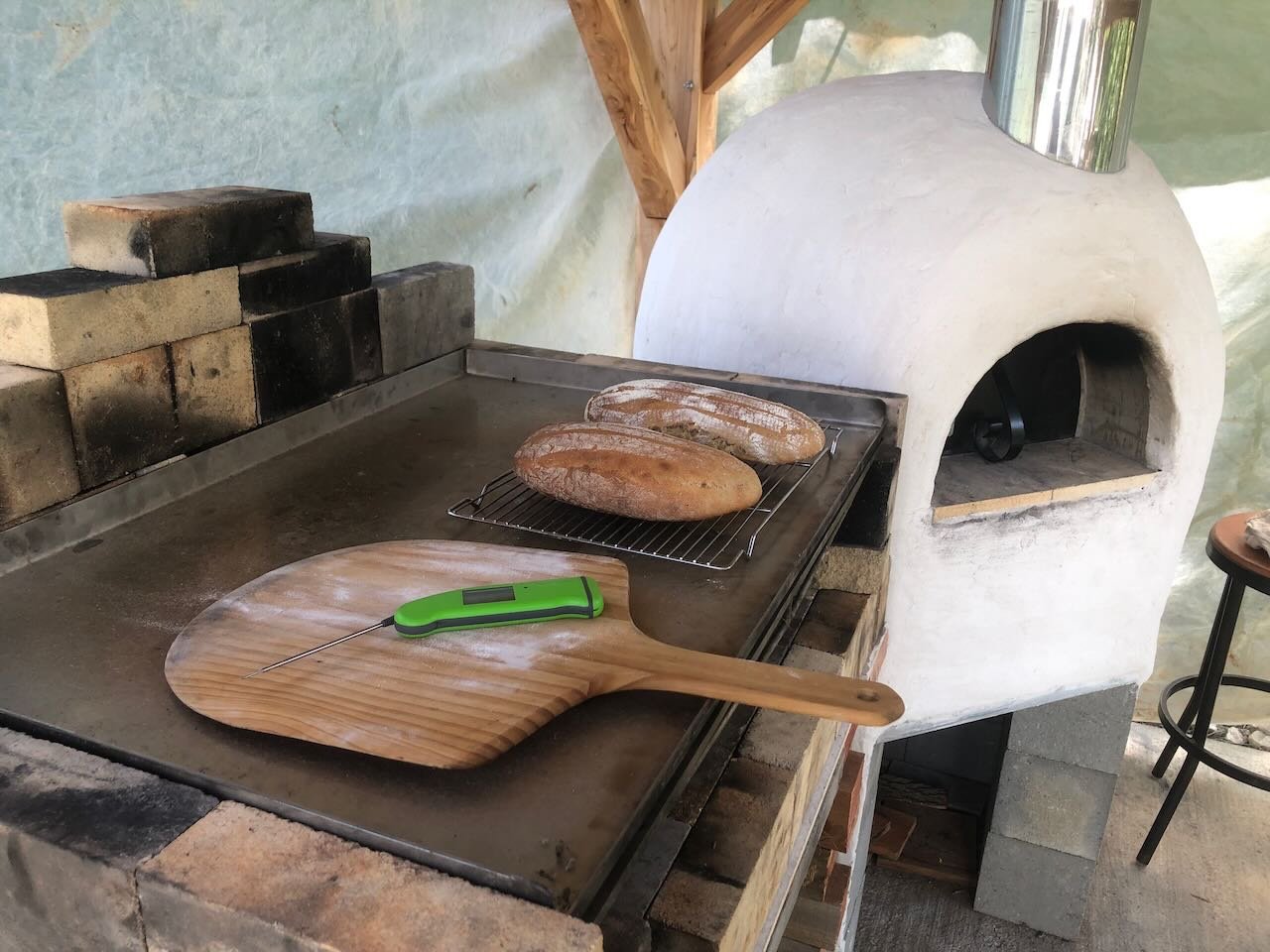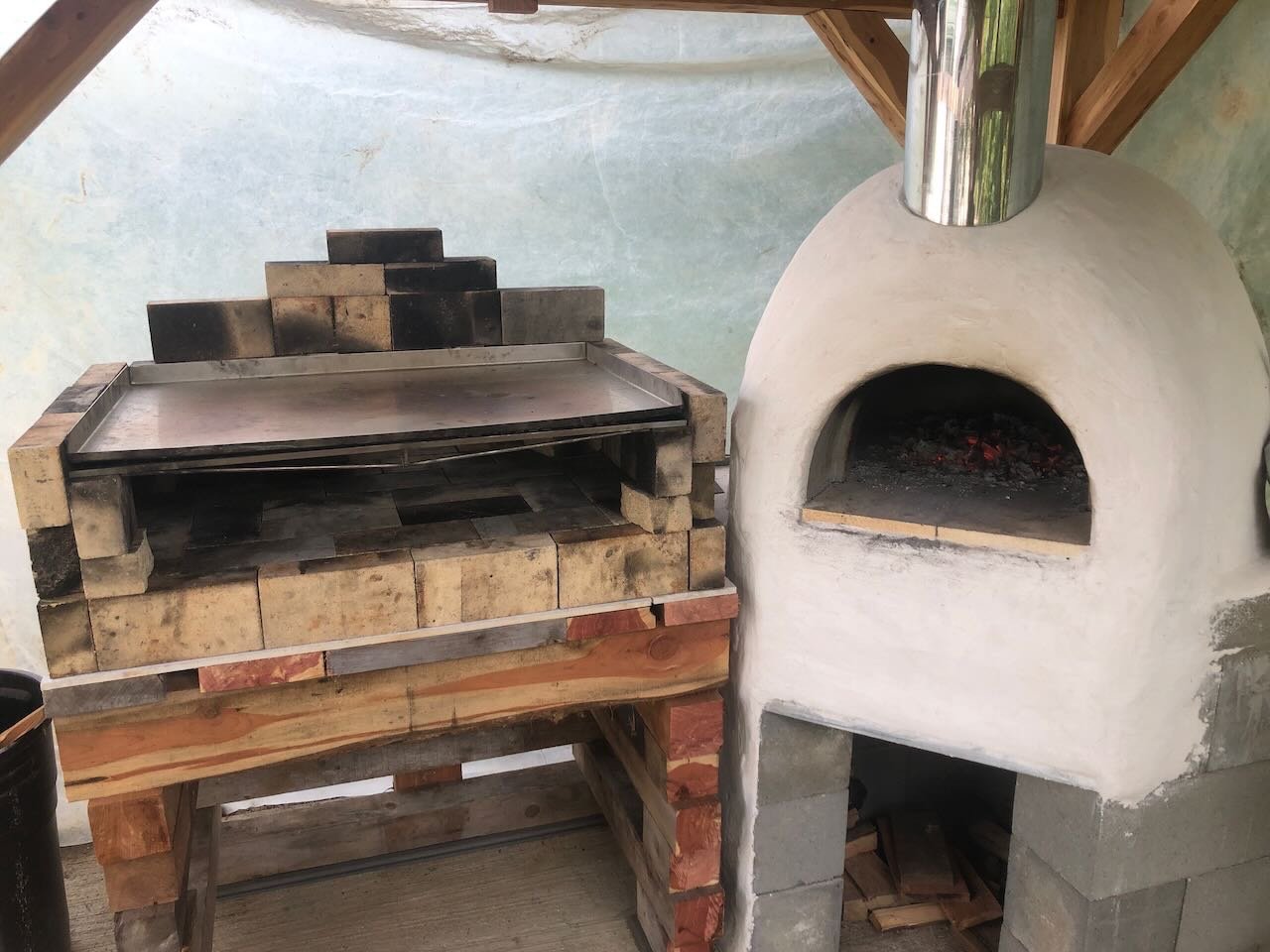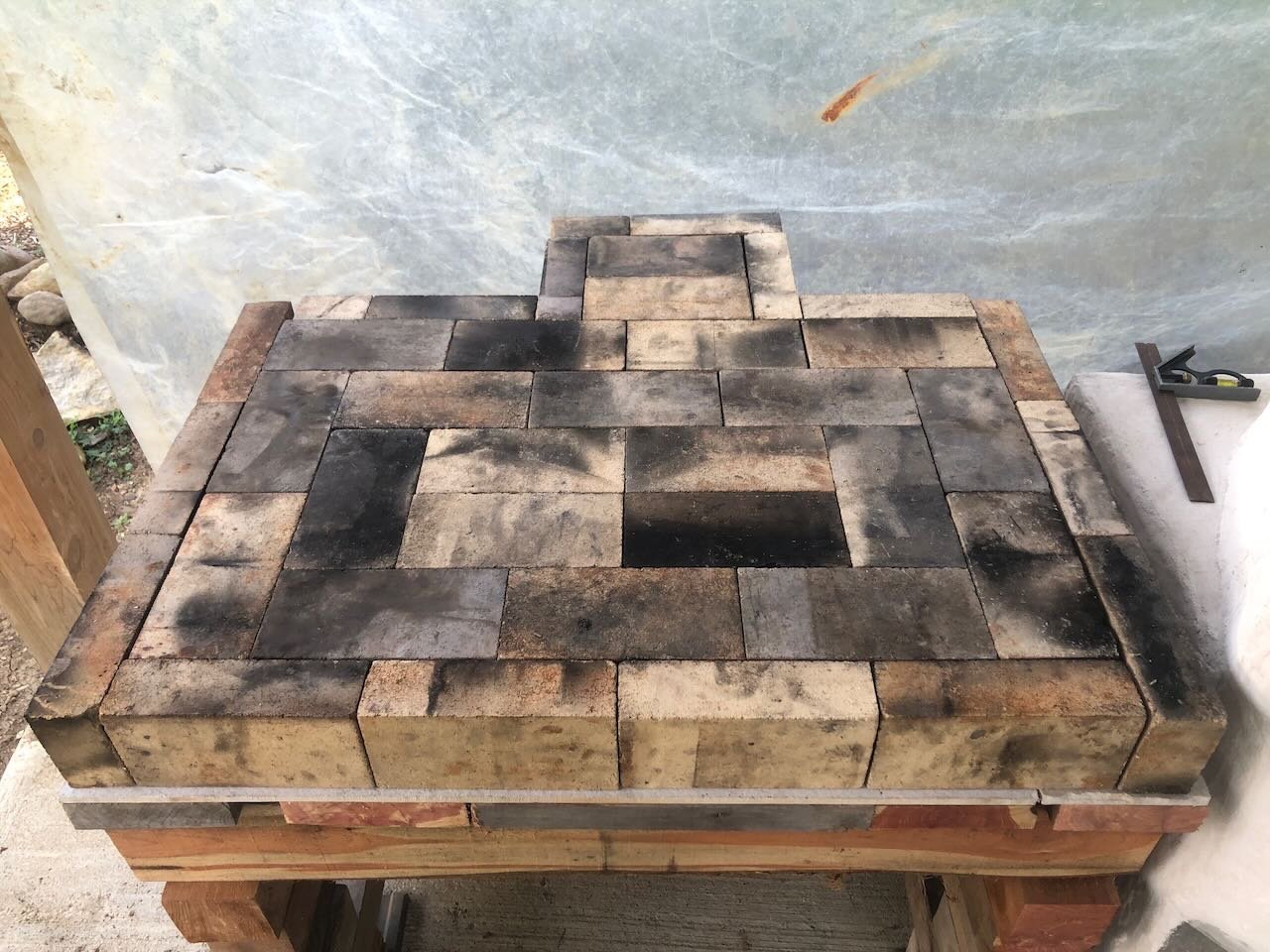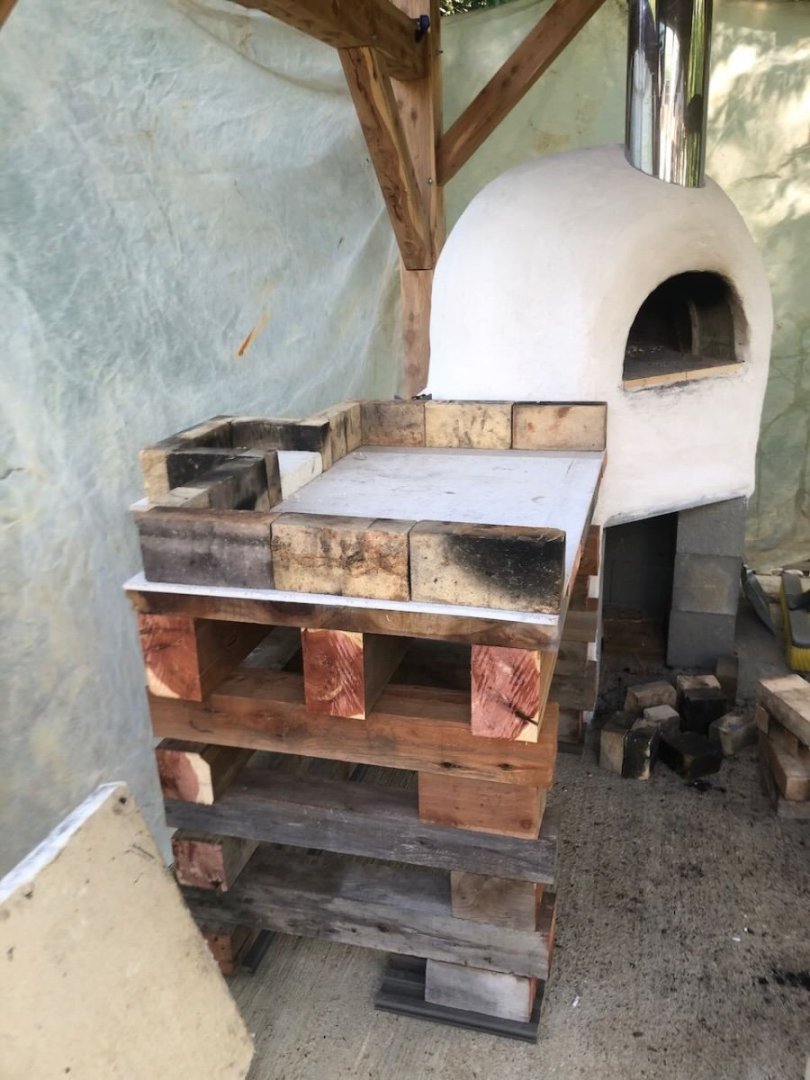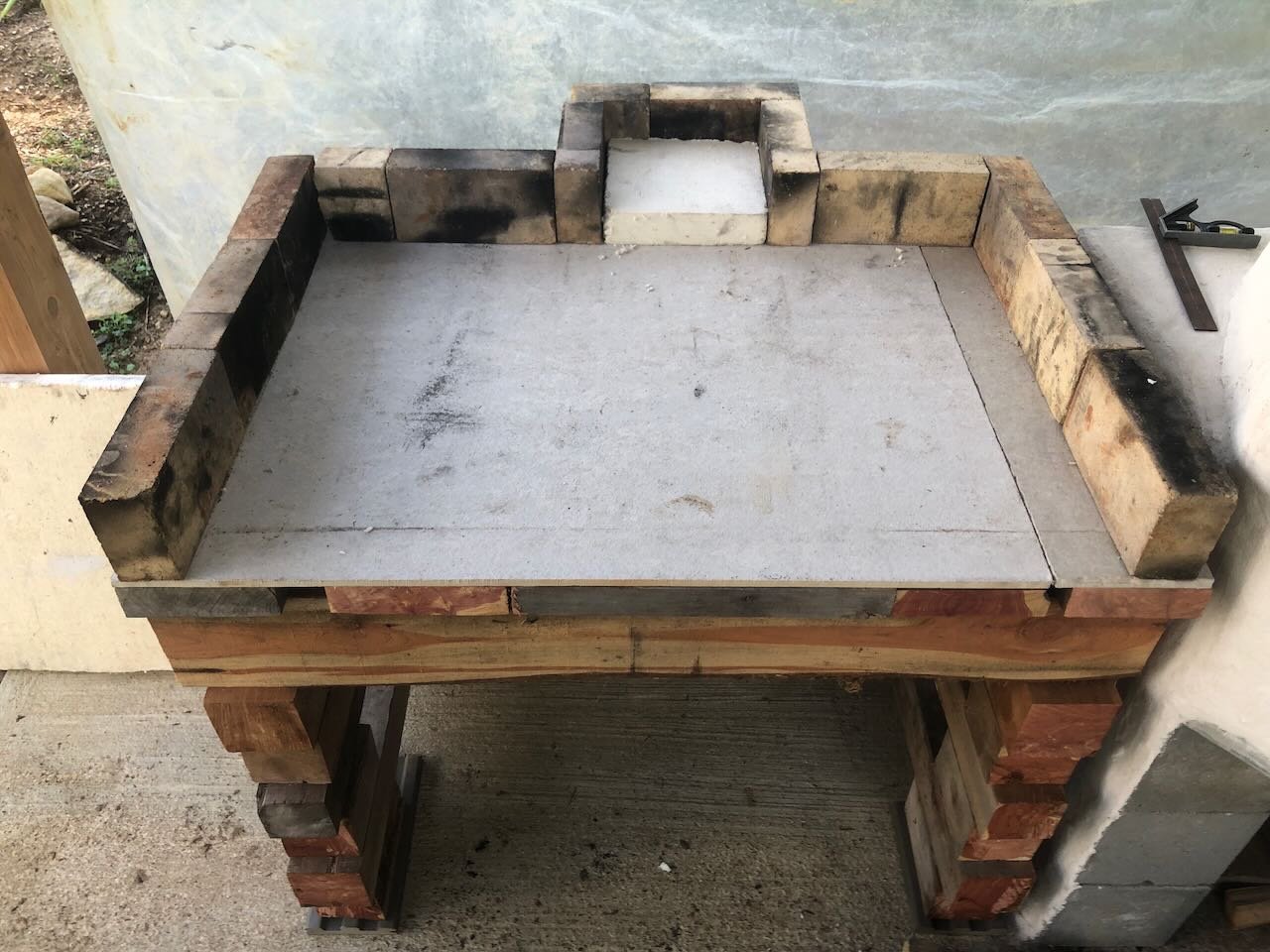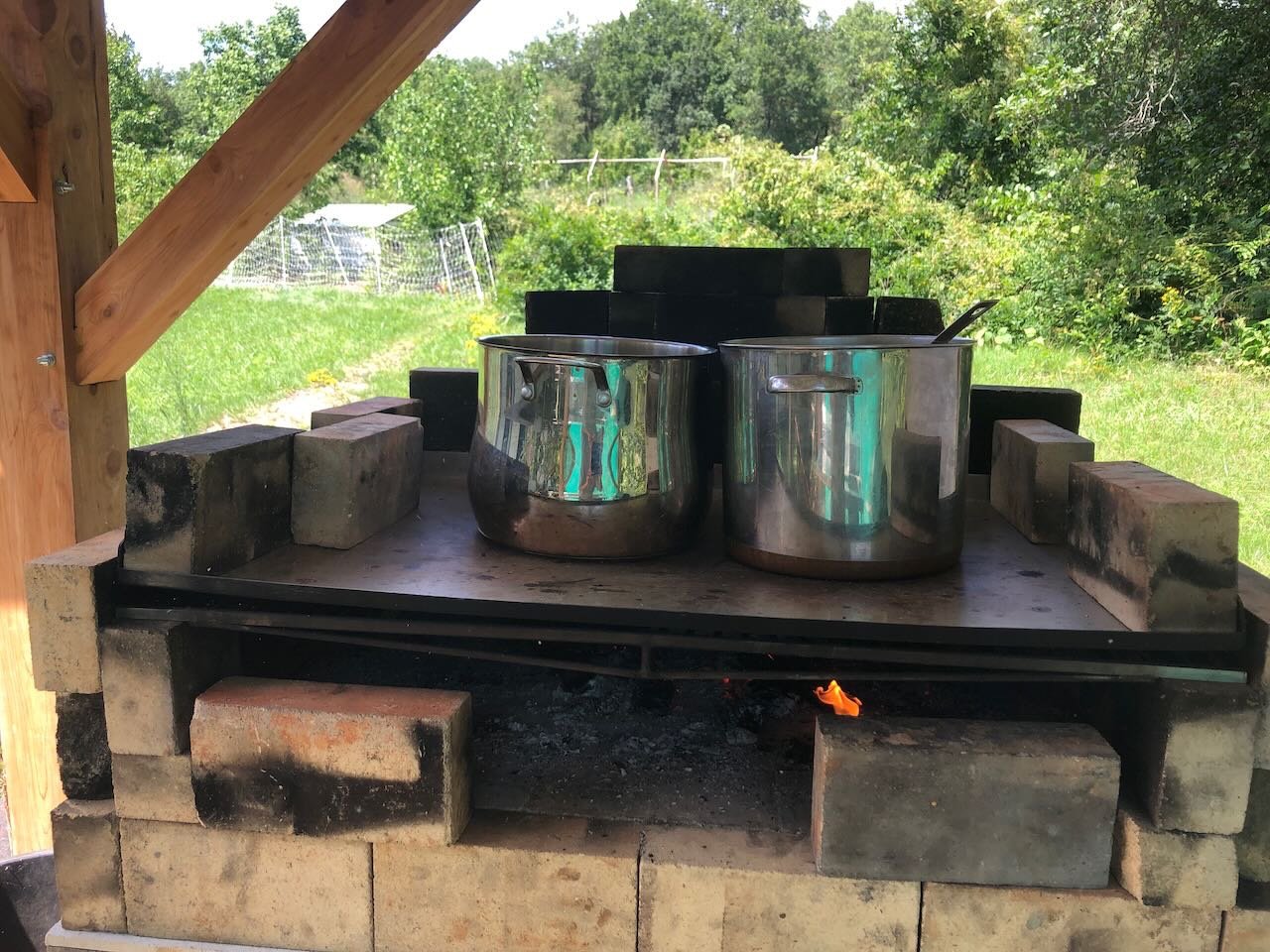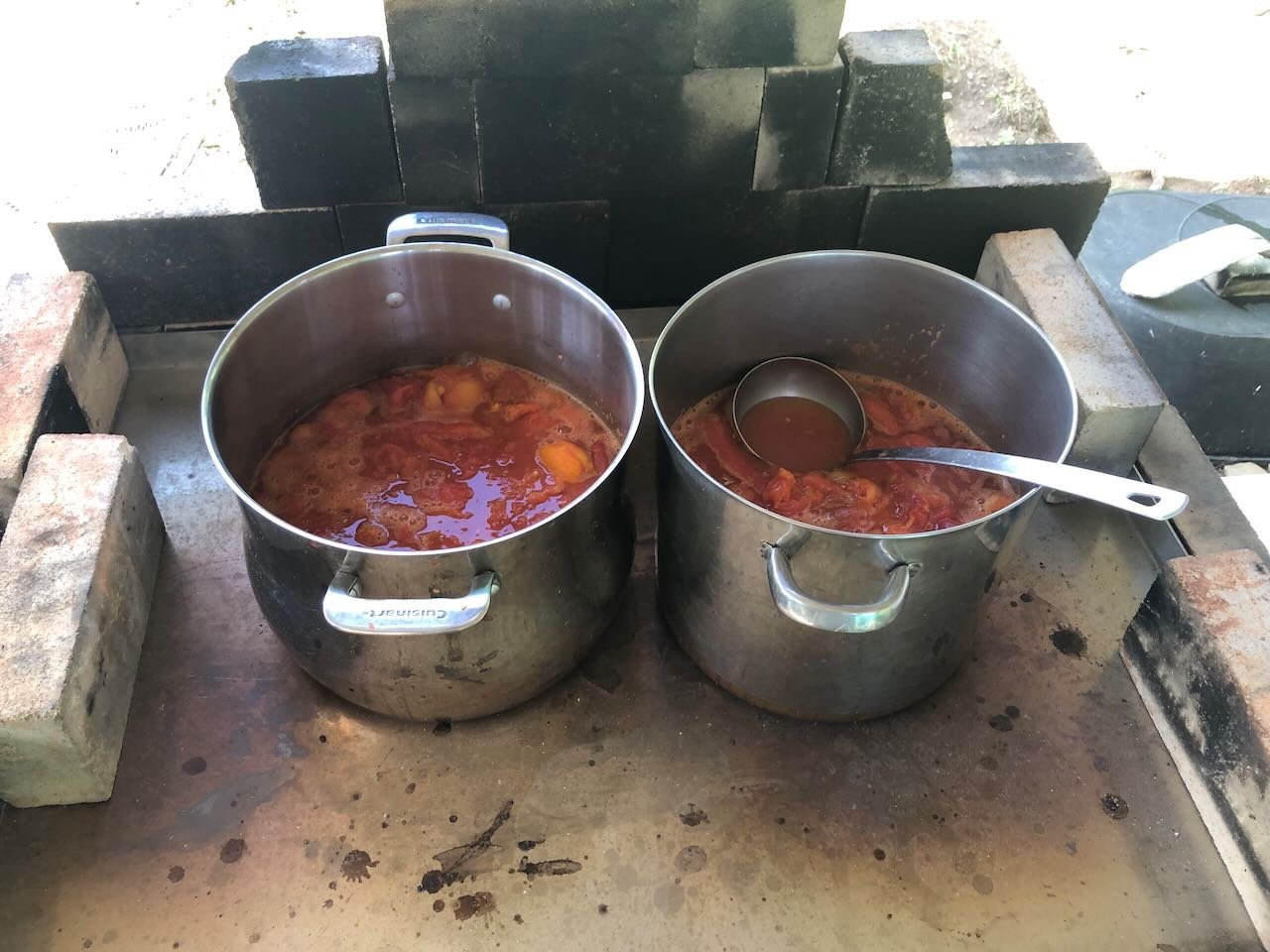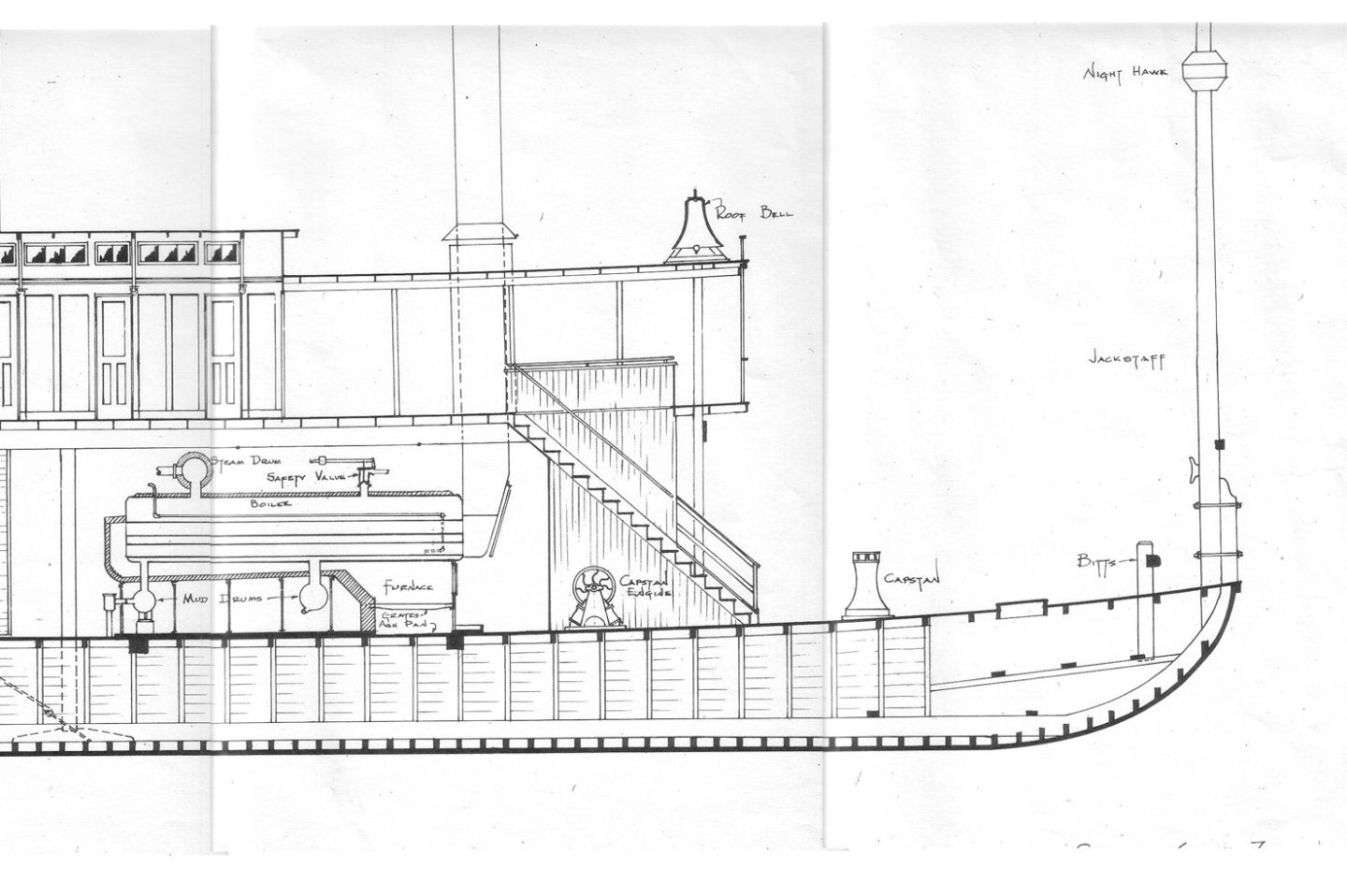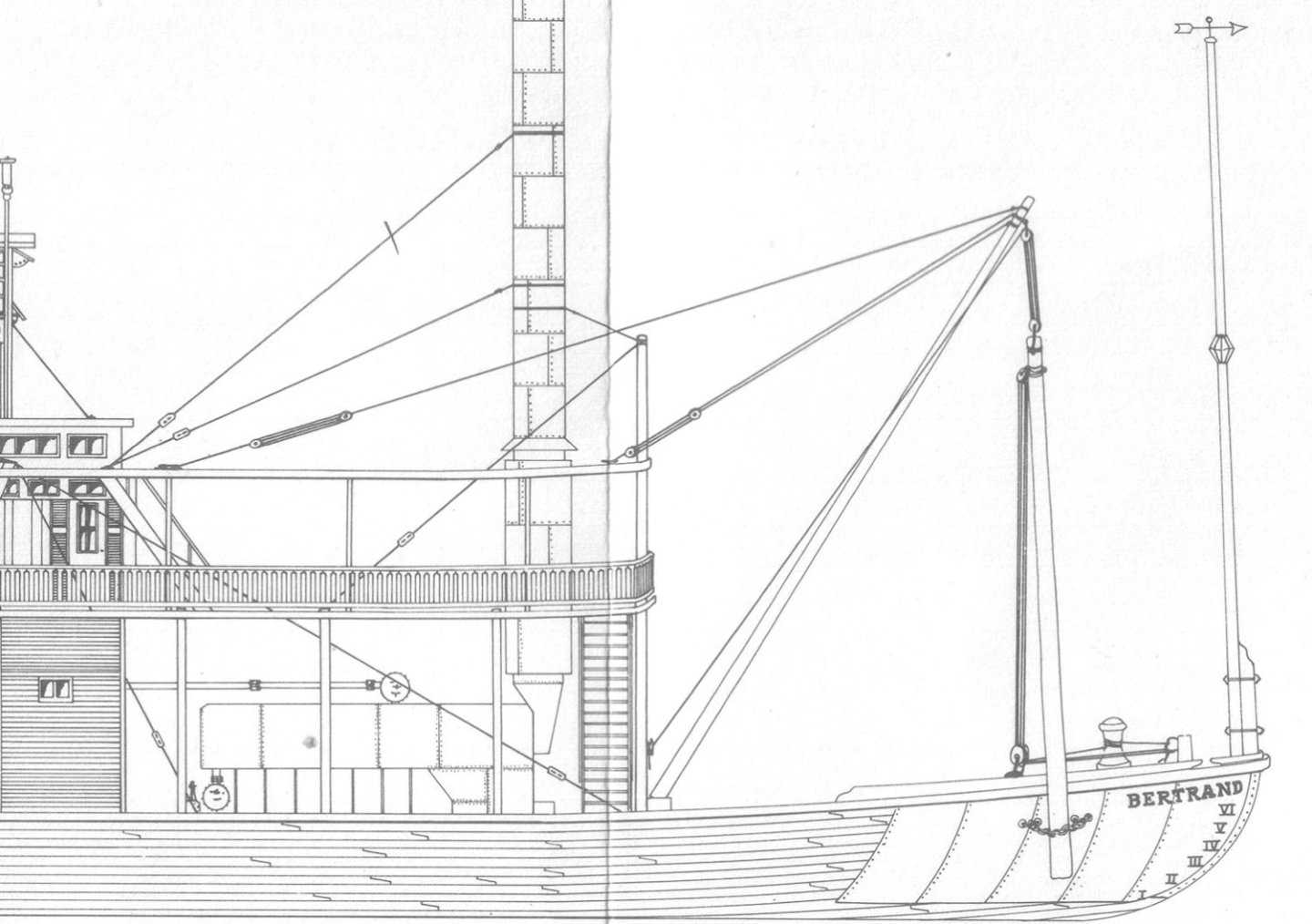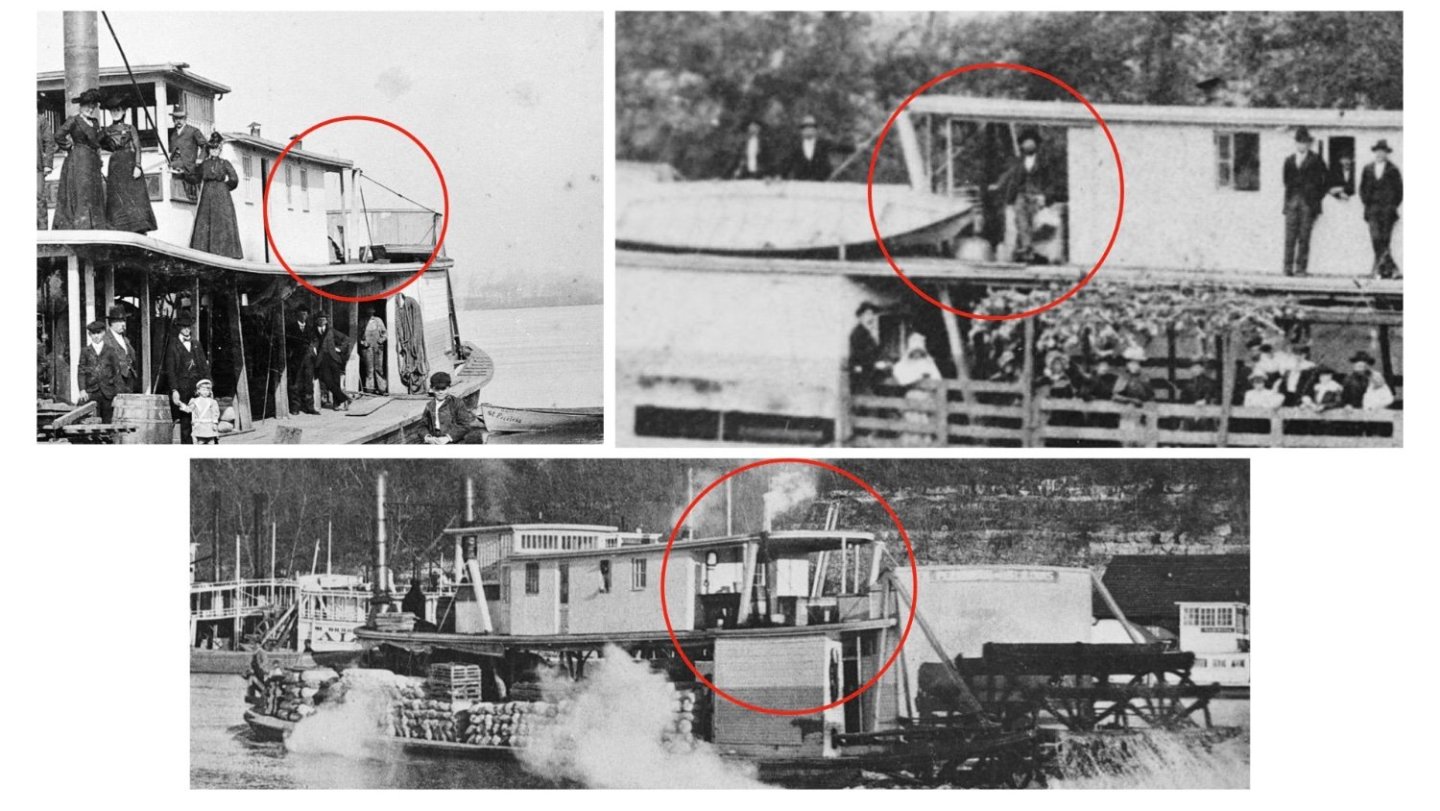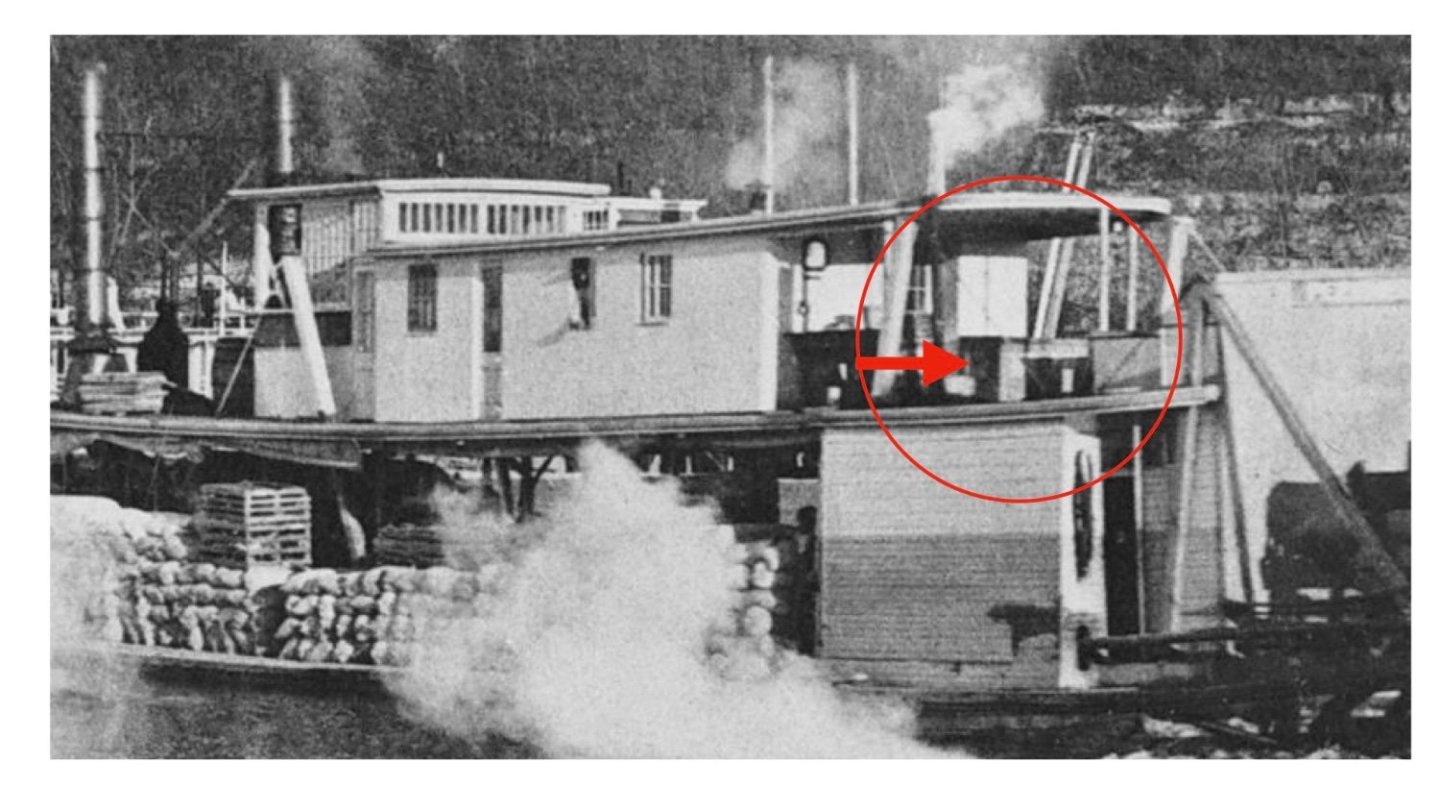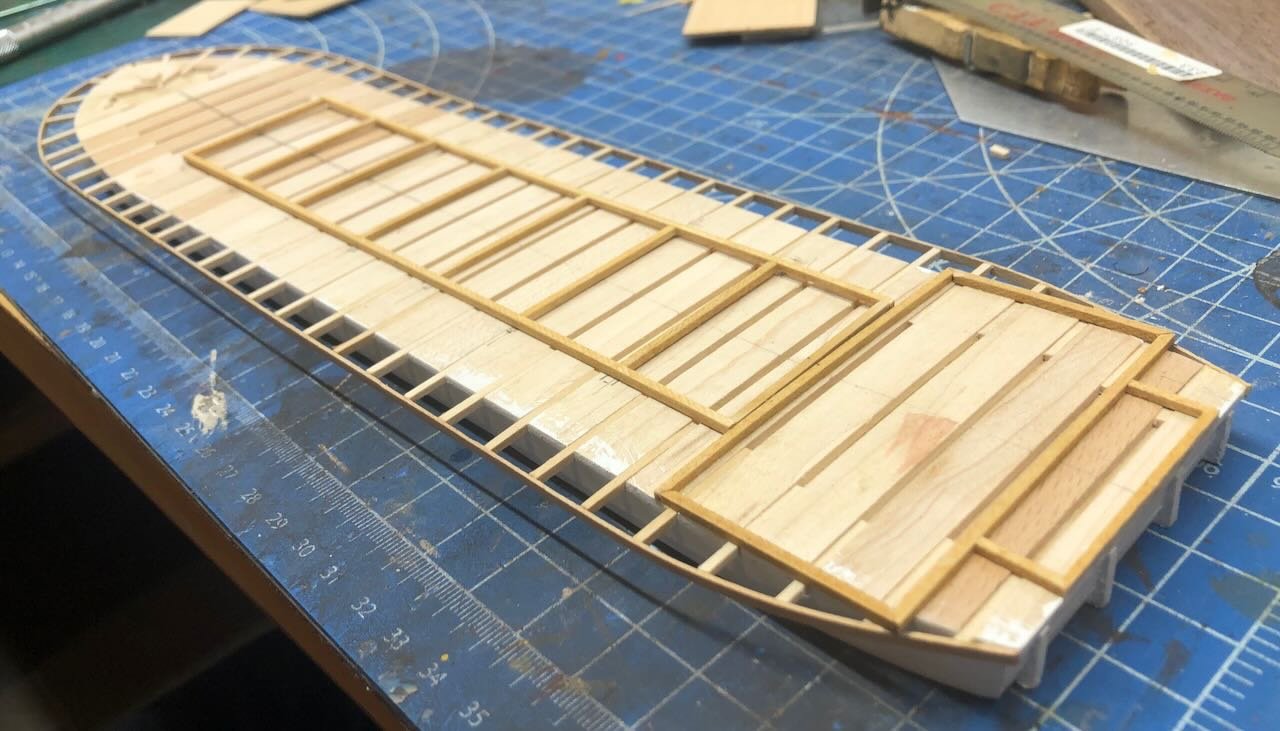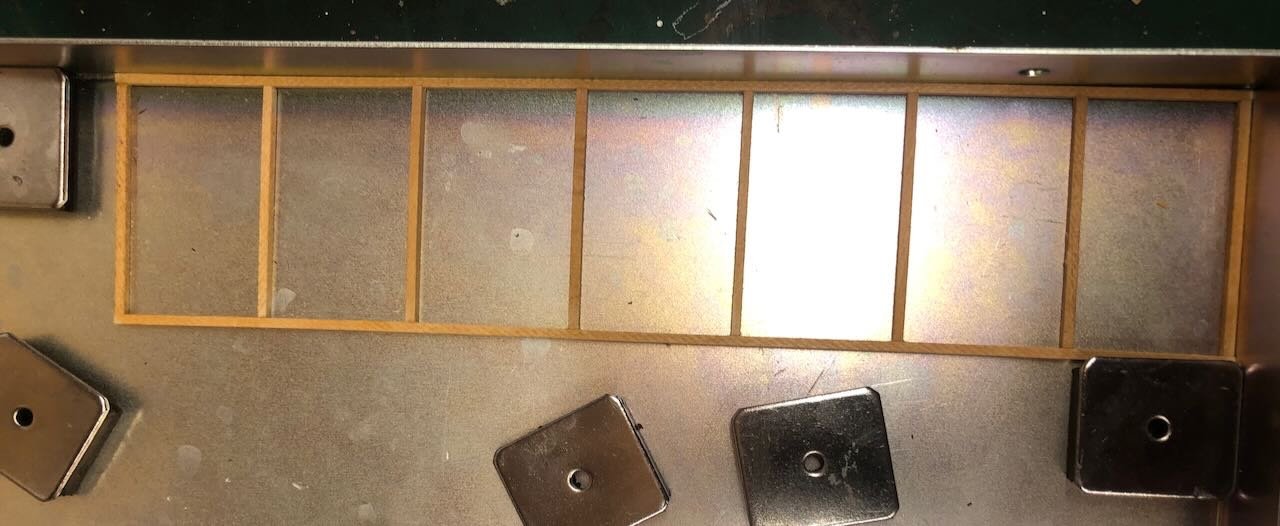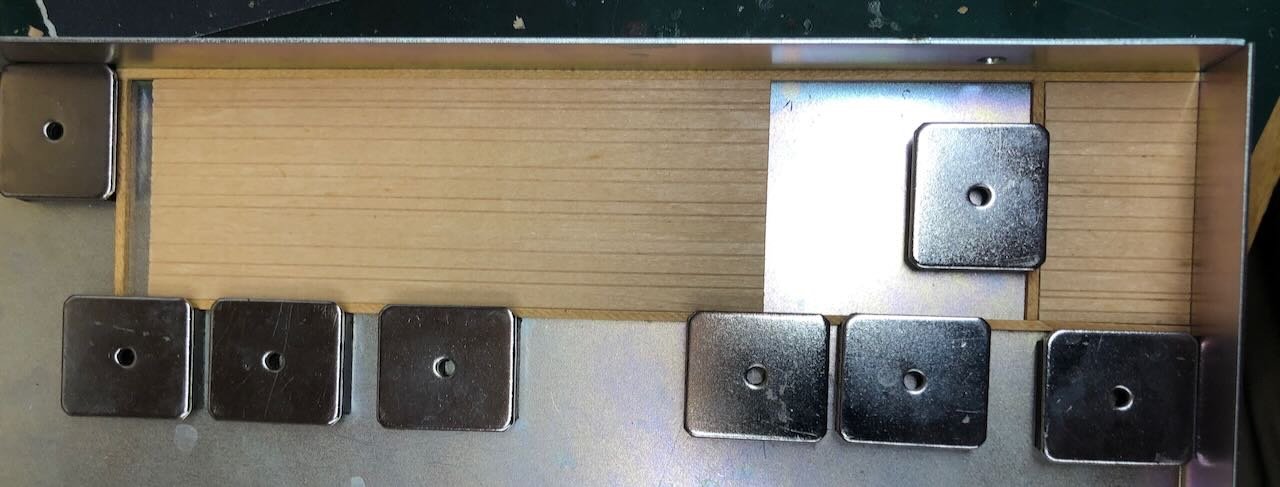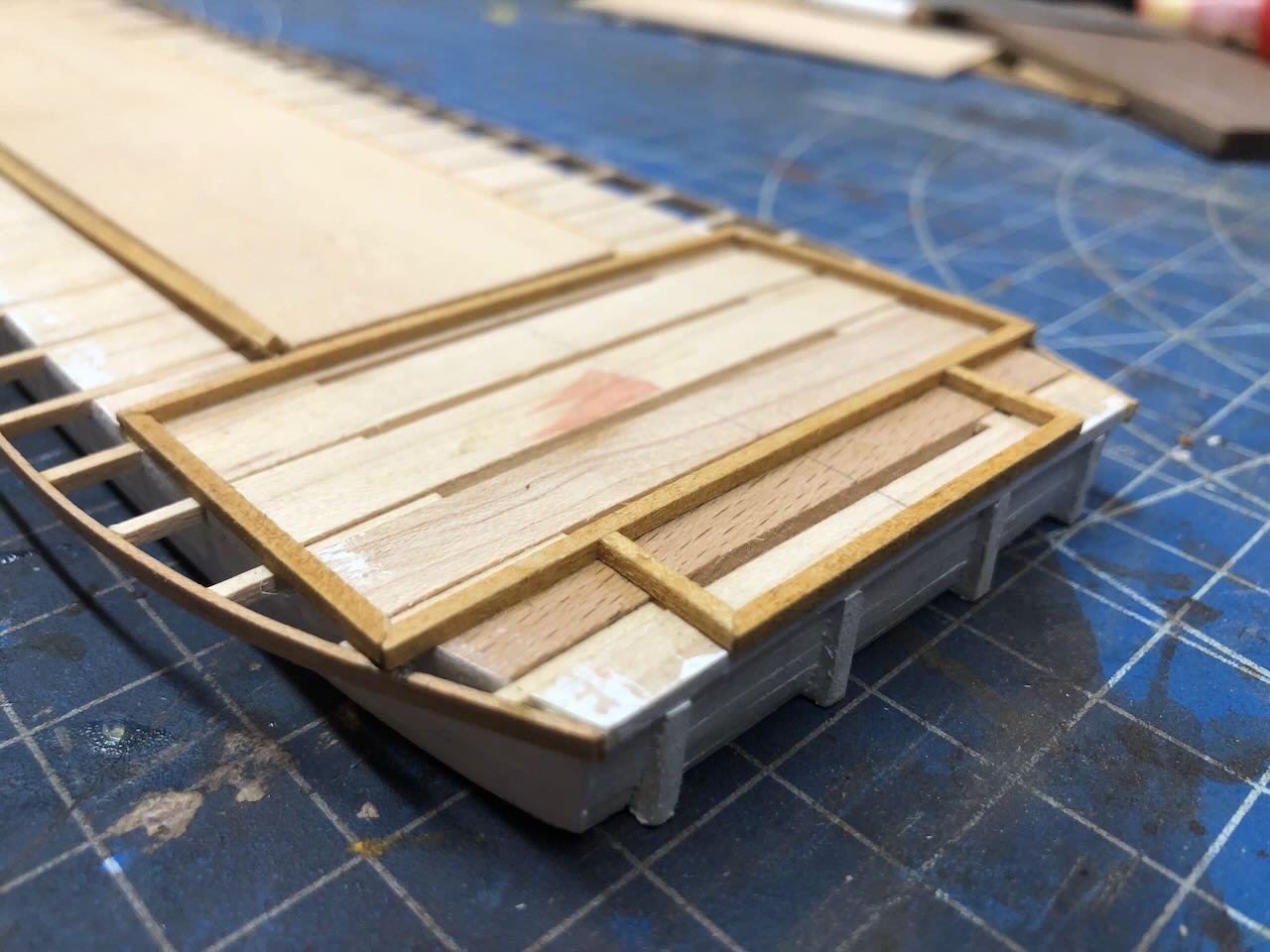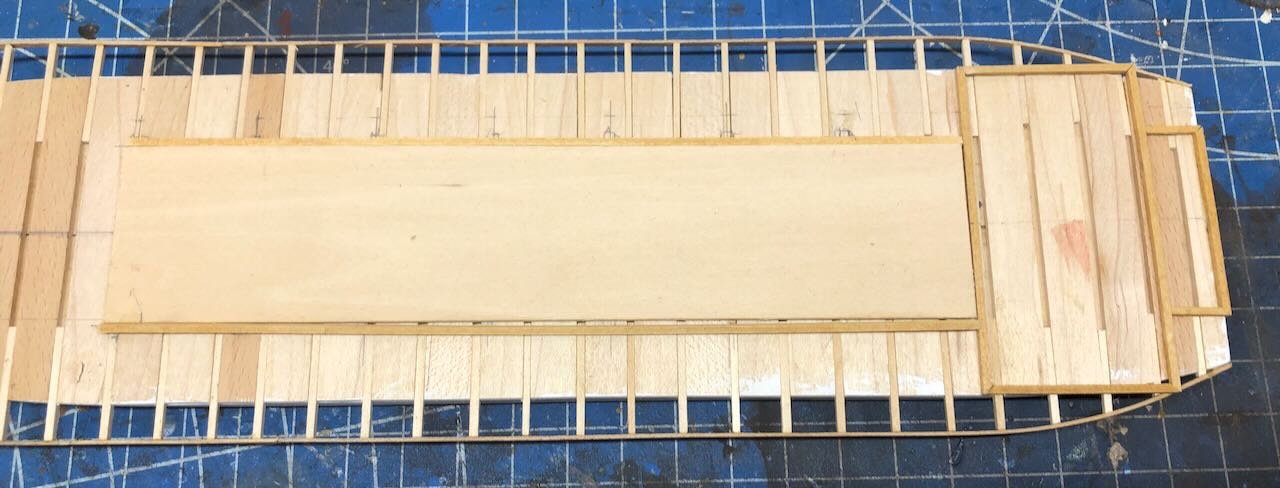-
Posts
3,487 -
Joined
-
Last visited
Content Type
Profiles
Forums
Gallery
Events
Everything posted by Cathead
-

Old eyes and shakey hands needs some advice
Cathead replied to David Rice's topic in Wood ship model kits
I completely agree about the potential value of building smaller craft in larger scales. Another thought occurred to me while reading the responses here: maybe consider altering the purpose of your modeling and trying models that are simpler and more artistic, more representative than to-scale? For example, I could imagine a really neat-looking modern towboat and barge set built from basic lumber that would simplify details but capture the essence of the vessels, especially if the finish and presentation are well thought out. Or maybe a cargo ship with relatively simple lines? Think of it as 3D art rather than literal scale modeling. And something like that could still have value beyond your own collection; if it's a design relevant to your region, then a local library, small museum, or historical society might still value a model that would engage the average visitor. Even a simplistic model helps people understand the three-dimensional nature of a vessel, better than a photo or drawing. For example, here's a pretty simple model of the Missouri River steamboat Bertrand, proudly on display at the museum displaying her artifacts just north of Omaha, Nebraska (all photos mine). Something like this would be more manageable than a truly scale model, but still has a very real role to play in engaging visitors. Note that the museum prominently displays this alongside a much larger, more detailed, very much to scale model: Both have a proud place in the museum's collection. If nothing else, the simpler one is probably more understandable and accessible to kids than the giant hyper-detailed one. I wonder if you'd consider something similar that would work for your current abilities yet be of real value to a local entity? EDIT: Shortly after posting this, I ran across a perfect example of what I'm talking about: the current Australian Couta boat build by @Louie da fly. As the builder (Steven) wrote, "It was never intended to be a 100% accurate model, more just something simple that could be made easily to raise funds..." but it so far it seems to me to do a great job of capturing the essence of a specific design of regional historical importance while being a relatively straightforward design and project, compared to a truly scale model. -

Would you buy pre-owned wooden kits?
Cathead replied to Frank Burroughs's topic in Wood ship model kits
I second Bob's advice. Older kits are very likely to have subpar quality materials, especially things like cannons, fittings, and rope, even if the wood is fine. Any money you save may well be sucked up by upgrading these items. And it's much more likely the instructions are poor, or at the very least make a lot of assumptions about your knowledge and skill set. Experienced modelers can enjoy the challenge of such kits, but there's a good chance they'll be a trap for a newer builder. Start with a new kit from a really reputable modeler, something small enough to not feel like a giant outlay if that's a concern, and use that to develop enough skills and comfort that you can then dive into "restoring" older kits. -
This is a spectacular model and a real joy and inspiration to follow. Thank you so much for sharing your detailed progress with us! I will miss this log...
- 208 replies
-
- kitbashing
- Woodcarving
-
(and 4 more)
Tagged with:
-
Forgive me for a slight diversion, but this discussion of side rudders and the note about one on each side really fascinated me, as I recently purchased a kit that converts a regular canoe into a sailing vessel. As it's difficult to mount and operate a centered rudder on a canoe, this setup uses dual steering oars mounted on a cross-beam. The idea in this case is to use one at a time (whichever is on the lee side) and let the other trail in the water. These also swivel horizontally and vertically so you can store the unused one up on the stern. The system works amazingly well, but I had no idea the dual-steering-oar setup had such a pedigree, I figured it was a modern hack to make the canoe-sailing thing work! To illustrate the point, here's the setup in my backyard and in action on a local lake. Having learned to sail on normal sailboats while growing up along a US Great Lake, the whole side-oar thing was new to me in practice (though I was familiar with its use in Viking vessels); it does indeed work very well. I don't want to derail this thread into a long discussion of canoe sailing, I was just fascinated by the convergence of ancient and modern.
- 508 replies
-
I've used simple artists' pastels to weather models for a very long time, including my past steamboat models logged here, as well as various model railroad applications. If it were me, I'd take each hatch plank and rub a bit of suitable pastel or weathering powder onto it. The inevitable slight different in application thickness and style will likely give you the subtle effect you're looking for.
-
I just have to say, as a spectator and not a builder, I would love dearly to see video of a largemouth bass striking a model tug. Move over, JAWS. Too bad you can't mount harpooning gear on her!
- 72 replies
-
- Seguin
- BlueJacket Shipcrafters
-
(and 2 more)
Tagged with:
-
I've made it about halfway through the decking. Just a slow process of cutting and laying planks one row at a time, trying to keep them parallel with the centerline. It's definitely more challenging with home-cut planks as every strip has slightly variable dimensions, so laying out each run is time-consuming. I'm definitely still an amateur at cutting out consistent scale lumber. Therefore this has been a lot more like planking a hull, in which each deck plank is a mini-project, than planking a deck with nice consistent commercial strips. So I end up laying a couple strips every evening, or whenever I can steal a bit of time. But here's what it looks like so far: The photo makes it look better than it is; the work is actually pretty rough. The planks are thicker than I initially intended, and the surface is pretty variable. I intend to sand the deck down smooth once the planking is done. There are also some disturbing gaps between some plank edges that I expect to need some sawdust filler on. The good news is that (a) unlike a sailing vessel, most of this deck will be relatively hidden, and (b), it's supposed to look rough-built. You can see the two parallel lines of holes left in the decking, where the boiler deck support posts would go. If you recall the framing I built in the last update, I used that to lay out exactly where the posts should lie and carefully arranged the deck planking runs so that the post holes would fall within a single run of planks. I started at the center and worked my way out, to help ensure that everything stayed parallel to the hull. This has worked well, but its downside is that the "best" planking got laid down the center where it'll be mostly hidden while the most visible planking (along the outer guards) will be done with whatever dregs I haven't used yet. I may end up cutting some more planking to avoid this potential problem, as I can tell I'm slowly concentrating the most problematic pieces in the so-far-unused pile. But it's progress, and I think will turn out well enough in the end. Thanks for sticking with the slow progress on this part.
- 393 replies
-

Timber-framed outdoor kitchen - Cathead - 1:1 scale
Cathead replied to Cathead's topic in Non-ship/categorised builds
Gregory, the scent fades quickly when the wood is in open air, so there's none around the kitchen. Indoors, especially in confined spaces, it remains strong much longer. For example, I built a simple cedar chest several years ago for storing woolen sweaters, and that retains an intense aroma when you open the lid. Thanks for the likes & comments! Some of you may be now planning a road trip to central Missouri... -

Timber-framed outdoor kitchen - Cathead - 1:1 scale
Cathead replied to Cathead's topic in Non-ship/categorised builds
Here's another upgrade to the outdoor kitchen. This time I built two stone-topped work stations that provide more counter and storage space around the grill and oven. These are built from yet more on-farm cedar lumber, just stuff I had lying around from previous projects. The stone tops were free; we got them from a counter-top place in our region that has a giant discard pile of waste stone left over from their own cutting projects. They have pallet upon pallet of this stuff sitting outside, that they have to pay to dispose of, but they're thrilled for anyone to come and take whatever they want for free. We have lots of slabs from them that we use around the house for various purposes, and selected this pair for their nice finish and appropriate size. They have minor flaws (aren't cut/trimmed quite square, rounded edges aren't polished) but we don't care about that. They make great work surfaces, easily cleanable, and are appropriate additions for a couple of geologists. The slabs simply rest in a three-side wooden enclosure; the whole structure is heavy enough that they aren't going anywhere. Here are a few more views. These make it so much easier to work in the kitchen, since there's now plenty of space to place ingredients, pans, etc. as well as storage for implements like fire pokers and ash pans below (out of the way of food). With these, the essential infrastructure of the planned kitchen is complete! It's actually fun to go back and compare to the original 3D digital model I developed as a loose guide to the planned concept: The oven and sink are where we initially planned them, while we've swapped the location of the smoker and grill; the latter is also larger than drawn above and the extra work table has been broken into two smaller ones. But the basic idea is the same, even down to the trellis along the west side. So much good food has been coming out of this on a weekly basis, it's still a bit stunning to us. The project isn't complete, there are various aesthetic upgrades planned. For example, we still intend to cover the oven dome and foundation with local river rock mortared in place, though that probably won't happen until next spring as it will take us time to collect and we won't have time to do the overall work before the weather gets too cold for curing mortar. I also intend to mount two clean buck skulls with antlers in the opposing gables; that I'll hopefully get to in the next month. And we'll keep coming up with small tweaks as we use the facility more. But functionally, it's complete! After almost a year of direct work, and much more than that of dreaming, planning, logging, milling, and so on, we finally have a functional outdoor kitchen that's exceeding our dreams so far. Yesterday (Saturday) we fired it in the morning and hosted two pizza parties for friends (noon and evening), and in between roasted another batch of venison, lots of tomatoes and onions, pans of okra and bitter melon, a tray of sweet potatoes, a dozen or so pitas, and so on. Once again we can eat for much of the week on what we cooked this weekend, in addition to things that went directly to the freezer for winter (like roasted tomatoes). I think you get the idea at this point. I'm not going to food-blog everything we do, but I'll keep updating this log occasionally as something new and interesting happens, either on the detailing or something new food-wise, like some especially fun food or using the grill to boil down maple sap in the spring. Thanks for tagging along on this rather unusual 1:1 scale project. It's been fun to build and share, and I appreciate all the interest, questions, and support along the way. -
You get what you pay for. Pinching pennies on a starter kit is just as likely to frustrate you as cheap kits are more likely to have poor materials and instructions. Investing in a kit from a quality company is a more reliable path to enjoyment and proper learning.
-
Looks like a very distinct project; I'll be interested to follow along. I strongly considered joining the Coast Guard as a youngster but life took me a different direction.
- 46 replies
-
- Fast Response Cutter
- Dumas
-
(and 2 more)
Tagged with:
-
On a "typical" sternwheelers, to the extent there was such a thing, the heads were hung off the very aft of the hull, where the waste was disposed of by the paddlewheel. This allowed easy passenger access from the boiler deck, the main passenger area. For example, see this drawing of Bertrand, where the heads are on the boiler deck overhanging the stern above the engine room. But as I mentioned earlier, no photos of Peerless show such facilities. For example: I don't know where her heads were, but a small stairway in the middle of the hull forward of the engine room doesn't preclude any number of other possibilities. The lack of "normal" heads is probably another line of evidence that she wasn't designed for carrying passengers. It's actually possible there's a small head on the main deck, hidden within the engineroom at the very back of the hull, which we can't see from external photos. That would be a logical location for a crew-only freight vessel, preserving the geometry of easy disposal without needing to build a separate structure up on the boiler deck. But again, that doesn't affect the location of the stairway further forward.
- 393 replies
-
Strong language is as renewable a resource as wood here! No chance of running out. I did a quick experiment to test out the aft stairway concept. I built a small cardboard mockup of an enclosed stairwell, using a 60º angle that's fairly steep but well within nautical tolerance for something intended for crew but not regular passenger use. In the two photos below, the boiler deck framing is propped up on some bobbins that happen to be right about a scale 8' tall, near-perfect. In the next two photos, I replaced the frame with a piece of cardboard with a "hatch" for the stairwell cut out, to better represent the solid deck. Recall that the framing on the main deck, aft of this, is where the solid engine room superstructure will be. This seems to work. The stairwell accesses the main deck right at the centerline, a bit forward of the enclosed engine room, and accesses the boiler deck just aft of where the upper superstructure ends, as hinted at in the photo discussed above. This would be a sensible place for a crew stairway. I think this would work, both on the model and in real life. Anyone see a reason otherwise?
- 393 replies
-
That's definitely true of me, the design is constantly playing in my head. I find, over and over, that I bog down if I try to draw complete plans and schedules. I seem to enjoy the fluidity of building as I go, even if it gets me into corners at times. I also seem to like the problem-solving when I actually have the wood/model in my hands, as opposed to when it's just on paper or pixel.
- 393 replies
-
Well, I was all set to get to work on planking when I realized there was another task to complete first. I'd completely forgotten about the extensions that support the paddle wheel. This is the problem with scratchbuilding; I can't rely on anyone else to have thought through a logical construction process! Since I don't have any really clear views of this area, just one blurry stern shot, I used modeler's license and came up with an approach that suited me. First, I made two L-shaped beams from scrap maple and carved/sanded them to a curved shape. Below left, a rough beam; below right, a finished one: When I test-fit these on the hull, I discovered that their natural angle of rest didn't angle upward as much as I wanted; these should continue the natural rise of the stern but due to local irregularities in the hull, they laid almost flat. Like this: So after composing some strong words for the designer of this kit, I set about fixing the problem by cutting and shaping very thin maple wedges that would elevate these beams juuuuust a little. Here's the result; much better: Here are the wedges in place, from above: And here are the wheel support beams in place, with suitable filler on either side: With those in place, I really do think I can turn to deck planking. So I spent the rest of the evening cutting a large and chaotic pile of planks from scrap cherry, using my Byrnes saw and NRG thickness gauge (thanks, Kurt!). Here's the hull with a tin of planking. This stuff isn't entirely consistent in thickness or width, and it's going to be an adventure laying out a nice deck. I cut it a bit thick, assuming that I'd want to sand it down even, so that's not too much of a worry. And as has already been said, these backwoods boats are allowed to be a little chaotic in their construction. So we'll see how this goes. Thanks for reading, and for any likes and comments you're generous enough to share.
- 393 replies
-

Timber-framed outdoor kitchen - Cathead - 1:1 scale
Cathead replied to Cathead's topic in Non-ship/categorised builds
Another weekend, another step forward. Earlier in the week, I built a first draft of the firebrick grill planned as a companion to the oven, intended both for standard grilling applications and bulk cooking (e.g., reducing maple sap to syrup or boiling down tomatoes for canning). The plastic sheeting in the background was set up for a forecast of severe storms, to keep some windblown rain out while we were working on this. It will not be present when the grill is hot! I first built cribbing of 4"x4" cedar posts. Like other wood in this project, this was cut & milled on-farm, but these were mostly "recycled" in the sense that they were salvaged from other projects or were leftover waste (for example, cutoffs from longer posts). The top beams were 4"x6" to help support the weight of bricks across the open span. On top of these I laid a layer of cement backer board, using leftovers from the same material used to support the concrete slab on which the oven is built. As a reminder, here's the oven foundation with its open center, and the backer board in place: And here is the grill cribbing with its layer of leftover backer board and a first layer of bricks around the edge: On top of this, within the firebrick rim, I laid a sheet of 2" ceramic insulation board, again using material left over from building the oven. As a reminder, this stuff: I didn't take a photo of that fully in place, but you can see a small piece in the grill photo above, filling the 9"x9" square of the chimney. In the photo below, you can see the larger piece of insulation board propped up in the lower left corner, waiting to be installed: Once that was installed, I laid a full firebrick floor on top: Then built up the rest of the structure: This has a two-part grill insert; the lower layer is an open grill while the upper layer is a solid griddle. The lower one is for proper grilling, while the upper one is for pan-cooking. The goal of the latter is twofold: (1) to distribute heat more evenly from a fire below and (2) to keep smoke and soot off pans. We had these made to our dimensions by a small veteran-owned business that makes custom grills. There is a small chimney in the back to help draft the fire. It's intentionally low so it doesn't bring heat too close to the wooden structure. This will only be in use when we're out there (unlike the oven, which can be left alone for long periods of time), so I'm not worried about fire hazard. It's no worse than my smoker, which I regularly use with its short open chimney under the structure. All of this is dry-fit for the moment, because we assume we'll learn some things about configurations that we'll want to change (e.g., chimney and grill height). Eventually the plan is to solidify everything by rebuilding the cribbing with proper notching to hold everything in place, and to relay the firebrick with high-temperature mortar. For now it's plenty stable for daily use and we'll experiment over time to decide on a final design. The griddle is already coming in handy as an extra work station when using the oven, since I haven't yet built the other work tables planned: Today we gave the grill its first test, by heating water to process tomatoes for canning, while running the oven itself for various weekend food projects (roasted potatoes, sweet corn, a big fillet of salmon, etc.): The first hot-water bath helps to skin the tomatoes, after which we started heating multiple pots to cook them down for actual canning: It's wonderful to have all this energy and heat stay out of the house on a muggy summer day. We're doing the actual canning in the house to ensure proper temperature control in that critical step, but doing all the prep work outside saves a lot of A/C energy! The other nice part about the covered grill is that we can cook using scrap cedar from my wood shop; we don't want to use this in the oven because it's very resinous and shouldn't be burned in anything with a proper chimney, but it's a fine hot-burning wood for open cooking. Another way to recycle materials instead of wasting energy. At times we'll still want to use hardwood for better coals (cedar doesn't form much of a coal bed). The next project will be building a couple of stone-topped work stations on either side of the oven-grill complex. These will use more scrap cedar lumber and cast-off fragments of stone countertops, which we get free from a local stone countertop business. More on that when I get to it. As a final note, since this came up earlier in the thread, here's an example of using the open space under the oven to store cured firewood. The open space under the grill serves the same purpose: -
Just found this while looking for recently started build logs to support. You're making good progress on a complicated model. Think of all the planking work as a tradeoff for all the rigging you won't have to do, compared with a typical three-masted sailing ship.
- 58 replies
-
- Robert E Lee
- Amati
-
(and 4 more)
Tagged with:
-
Awesome insights, Roger. Your explanation of stability fits well with my intuition but I didn't have the background to understand or explain it properly. Thanks! Also agreed that the photos we have of Peerless carrying passengers clearly look like charter events, not routine transportation. She almost certainly started doing this to make up for insufficient freighting as railroads took hold. This one is a great example (note the band): I agree that I don't think Peerless had folding stacks even though she's from the era when they were in use. I think she's too small too need them; I suspect her full chimneys are still more than short enough to pass under bridges of the era. I mean, she's missing an entire deck compared to a "typical" Missouri River boat.
- 393 replies
-
One more question to address is that of stability, related to passengers moving around decks without railings. While as far as I know there were always railings around elevated passenger areas, it's also the case that these boats were pretty stable. It was routine to load Western river steamboats until their main decks were only a few inches above the river, telling you that they weren't expected to pitch or roll much. It's quite possible for strong winds to whip up waves (even whitecaps) on the Missouri River, and strong winds were the cause of quite a few steamboat wrecks, but the baseline operating conditions for these vessels were pretty stable compared to any open-water sailing. They had a low center of gravity and, especially by 1893, generations of knowledge regarding how to build stable vessels on the Missouri. Railings are sensible in any raised area where non-crew are present, but in this context probably more for general constraint than specifically for vessel motion.
- 393 replies
-
My goodness, that question sparked quite a discussion! Unfortunately that kicked off right when I went into a really busy stretch and couldn't keep up. Let's see if I can unpack it all. Stairs vs. ladders My strong impression, from extensive reading/research, is that between-deck ladders were rarely used on Western river steamboats. I can't recall seeing a photo with a ladder and every photo or plan I can recall has stairways between decks. I skimmed various references I have on hand and found nothing to counter this. Keith, thanks for your detailed thoughts, but I can't convince myself of the ladder you suggest in that photo. Moreover, the location of the man & child standing in front of the potential ladder strikes me as much farther forward than you indicate; to me they're standing directly under or just fore of the pilot house. That would be a very inconvenient place for it; emerging under the pilot house is impossible, and just forward of the pilot house there's no sign of any protection around the "hatch" that would be necessary. My personal opinion is that a stairway is far more likely and that I need to determine where it was. I continue to lean toward the location I identified at the end of my post and plan to build a cardboard mockup to test out the idea. I don't know why Peerless wasn't constructed with a forward stairway in the first place, like most steamboats, but one possibility is that she was built to be a cargo-only boat. By the late 1890s passenger river travel would have declined quite severely, and Peerless was likely initially intended to be that era's equivalent of a local towboat, handling local bulk cargo for areas not yet served by railroad but not really set up for long-distance passengers. As noted above, the boiler deck is where passengers would be carried, but (a) her cabin looks too small to accommodate more than a handful of passengers, (b) she has no outhouse hanging off the stern end (above the wheel) where passengers' needs would normally be accommodated, and (c) there are no railings along the boiler deck as in any boat I know of that carried passengers. And if she was designed for freight only, then there would be little reason to have a passenger-convenient forward stairway right in the way, when you could just tuck a crew-only stairway somewhere back in the engineering spaces. We do have photos of her hosting jaunty outings in this era, and it's possible a decline in freight due to the building of the MK&T railroad along the north shore of the river pushed her owners to diversify, but such outings would have occurred when she wasn't carrying freight, so passengers could remain on the main deck while the vessel was in motion. As someone noted above, the only photos we have of people crowding the boiler deck are taken when the vessel is clearly stopped and staging a photo shoot. Chimneys (stacks) To the best of my knowledge, based on references such as Alan Bates and various plans, steamboat chimneys had heat shielding jackets placed around them from the boilers as far up as passengers were likely to encounter them. For example, here are two different plans for Bertrand, both of which show heat shielding around the chimneys as far back as her 1856 construction date. Note that these extend through the boiler deck (one above the main) to the roof of the hurricane deck (two above the main). The boiler deck was the main passenger area so the shielding was certainly relevant there. Passengers would normally not be allowed on the hurricane deck, so there the shielding ends as soon as the chimneys pass through the deck (also because above that the hot chimneys don't encounter anything flammable). In addition, Model Expo's Chaperon (1884) kit also clearly includes heat shields around the chimneys, with the instructions stating "There are two 1" diameter dowels, 2-5/8" long in your kit. These are the smoke stack covers. They were sheet metal cylinders that surrounded the smoke stacks to prevent the crew from coming into contact with the hot stacks." See quote on page 8 (link above) and accompanying Photo 12. Kurt Van Dahm's detailed publication on building Chaperon also clearly documents this heat shielding. So I think it's pretty conclusive that chimneys had heat shielding on their lower stretches, usually until they'd passed through the final deck. Above that they came into contact with nothing but guy wires and nobody but crew, who had to take their chances. No doubt it was still a hot place to stand during operation, but it clearly wasn't too much of a problem since standard steamboat design had the shielded chimneys passing right through what must have otherwise been the most popular outdoor passenger location (view forward, access to whatever breeze was available). Chimney painting This is a fun question that I had not thought about before. My initial reaction was the same as Brian's, that the identifying bands of city-class gunboats were painted directly on the chimney, not on any special heat shielding. All photos I can find seem to bear this out. My guess is that, by the time hot gases had made it that far up the chimney, they (and the surrounding metal) were cool enough not to blister paint off. Steamboats had very long chimneys to increase the draft of their boilers, and it seems to me that intense heat would bleed off quickly with height. But you'll notice that all the identifying bands of city-class gunboats were painted very high up the stacks; I'd always assume this was simply for visibility, but there's likely a convenient coincidence that this also minimized any heat-related degredation of the paint. A very neat insight if true! Wow that was a lot to think and write about. Further thoughts?
- 393 replies
-
Wefalck, thanks for checking on that. The image you reposted shows a later retrofit to add those stairs; they're not there in the original configuration. See the image I posted above that for comparison (and the descriptive captions), or consult the array of images presented in the first post of this log. Brian, I thought about that, too, as it seems the next most logical place. The problem is that I don't see any sign of railings protecting a stairway under that covered "awning". There also appears to be a door at the rear of the boiler deck cabin, right on the center line. For example: Funny, as I was writing and posting that, I suddenly saw that bottom-most photo in a different way. Is what I took for a large crate actually a solid-walled enclosure for a staircase, leading up perpendicular to the hull, starting near centerline in front of the engine room and coming out on the starboard side of the boiler deck? If so, that's why you don't see an enclosure in the photo at upper right, because the man standing within the red circle is standing in front of the opening down to the stairs, not alongside stairs running fore and aft. Here's a closer closeup:
- 393 replies
-
Here's the completed boiler deck framing, first in the magnetic square, then two shots resting on the main deck. I think the next step will be starting to lay the decking, for which I will be going back to homegrown wood, meaning I need to mill a whole bunch first. That means I probably won't make more progress until next weekend. But I do have a thinking-ahead question: Where were the stairs between the main and boiler decks on this vessel? Many steamboats placed them near the bow, in front of the boilers. But most of the main reference photos I'm using (see first post of this log) show no stairs there. A few photos do show stairs at the bow, but they appear to be a later retrofit, and aren't relevant to the earlier version I'm building. Here's a shot clearly showing no bow stairs: Here's a later shot (when she was operating down at Vicksburg and had clearly been altered) showing bow stairs: So where were the stairs in her Missouri River configuration? I've stared at all these photos over and over, and can't find any sign of a staircase. Anyone have insights into an alternate staircase location, based on actual practice in other vessels? There has to be a proper staircase, if nothing else because multiple photos clearly show crowds of ladies up on the boiler deck, and they sure didn't climb a ladder. And if it's not at the bow, it has to be much further back, because the boilers sit below the pilothouse and you couldn't put stairs there. That also forces passengers back into the engineering and cargo spaces, an odd choice; the value of bow stairs is that it kept passengers out of the crew's way. There's also no sign of stairs along the outer edges of the deck toward the stern, a location that would also keep the passengers out of the engine/cargo space. They almost have to be internal somewhere, but that seems really odd to me. Here's an annotated drawing laying out the question: Thoughts?
- 393 replies
-
That's so great to hear! To me, one of the great joys of model building isn't assembling, but understanding. You've done a great job on this model, it'll be an excellent highlight wherever you choose to display it. As for next model suggestions, while I can't know what would give you joy, if it were me, I'd go with one of their cargo vessels (tanker, Liberty ship, etc.). Lots of people build warships but merchant vessels are far less well represented in the modeling world and are fascinating in their own right. And it'd be a fitting tribute to all the sailors who served on such vessels but get only a fraction of the recognition their more famous naval colleagues receive.
- 25 replies
-
- Harriet Lane
- Model Shipways
-
(and 1 more)
Tagged with:
-

Timber-framed outdoor kitchen - Cathead - 1:1 scale
Cathead replied to Cathead's topic in Non-ship/categorised builds
This manufacturer offers versions that are completely finished; they'll truck it right to your door. As long as you have a route that it can be hauled along (they're not light), you could have this on your back patio: A lot more expensive, but practical if the money is there. https://www.fornobravo.com/product-series/primavera-series-wood-ovens/ There are larger sizes, too, you can browse the site. We're stubborn and wanted to have some ownership of it, plus the lower cost was relevant to us. As for covering, as shown above, when finished properly they don't need to be under cover. But being out in the open also limits the conditions in which they can be used. In our case, building the kitchen structure allowed us to (a) worry less about getting a perfectly sealed finish on the homemade oven kit, (b) make use of it in far more variable weather conditions, and (c) integrate it into a broader kitchen setting with grill, smoker, sink, etc. This was important to us as we saw this as an important aspect of our self-reliant homestead life, not just a recreational highlight (not that there's anything wrong with that). I fully intend to use this when it's raining/snowing/boiling. I'm so sad for you! I have family roots in southern Mississippi (among other places). We adore okra; sauted, roasted, in stews, you name it. I will say that okra is one of those vegetables whose quality is highly dependent on freshness. Grocery store okra is trash. Fresh okra from the garden is a different story. Okra does NOT store or travel well, it needs to be fresh-picked and used. And preparing it well does matter. I have found numerous people who thought they didn't like okra until we prepared it for them. But I do admit there's no accounting for some folks...;) -
I've started laying out the forms for the superstructure. Peerless, like many similar vessels, has a very simple deck layout: a solid engine room structure at the stern and a series of posts going forward. So I laid out the shape of the stern structures pretty easily, after some careful measurement and decision-making: If you're wondering about the coloration in the middle of the forms...it's what you probably think it is. Like all the rest of my models, there's now a little bit of me in Peerless! After this I started laying out where the posts would go. To do this, I cut a rectangle from a thin sheet of scrap wood in the exact internal dimensions I wanted, and laid it on the subdeck to mark out where posts would go. At this point, I also decided I would build the frame that rests on top of these posts, essentially the subdeck for the boiler deck (if you're confused, on Western river steamboats, the boiler deck was the deck above the boilers. No one knows why). Building this now would help ensure that I could lay a nice square structure on top the posts, rather than having to build it in place later. So here I'm laying out and cutting the longitudinal beams for this, again using my sheet wood as a guide: And here I'm using my magnetic squaring jig to begin gluing up this sub-boiler-deck framing, again using the scrap sheet wood as a form (this will not be present in the finished model): Once I have this sub-structure built, I'll lay it over the sub-deck to double-check my post locations, then it's time to start laying decking, being sure to leave holes for the posts. Thanks for reading!
- 393 replies
About us
Modelshipworld - Advancing Ship Modeling through Research
SSL Secured
Your security is important for us so this Website is SSL-Secured
NRG Mailing Address
Nautical Research Guild
237 South Lincoln Street
Westmont IL, 60559-1917
Model Ship World ® and the MSW logo are Registered Trademarks, and belong to the Nautical Research Guild (United States Patent and Trademark Office: No. 6,929,264 & No. 6,929,274, registered Dec. 20, 2022)
Helpful Links
About the NRG
If you enjoy building ship models that are historically accurate as well as beautiful, then The Nautical Research Guild (NRG) is just right for you.
The Guild is a non-profit educational organization whose mission is to “Advance Ship Modeling Through Research”. We provide support to our members in their efforts to raise the quality of their model ships.
The Nautical Research Guild has published our world-renowned quarterly magazine, The Nautical Research Journal, since 1955. The pages of the Journal are full of articles by accomplished ship modelers who show you how they create those exquisite details on their models, and by maritime historians who show you the correct details to build. The Journal is available in both print and digital editions. Go to the NRG web site (www.thenrg.org) to download a complimentary digital copy of the Journal. The NRG also publishes plan sets, books and compilations of back issues of the Journal and the former Ships in Scale and Model Ship Builder magazines.


